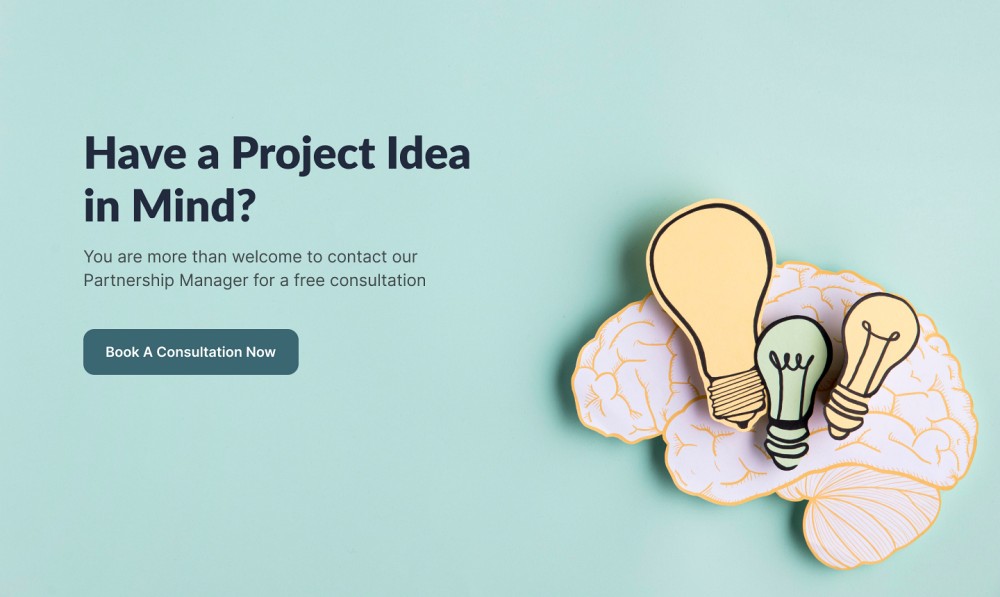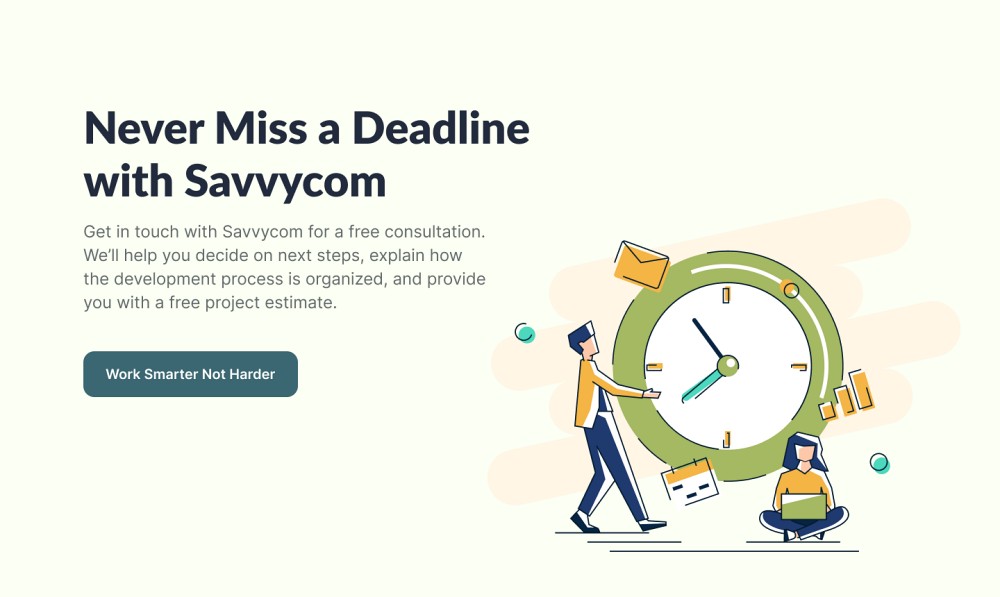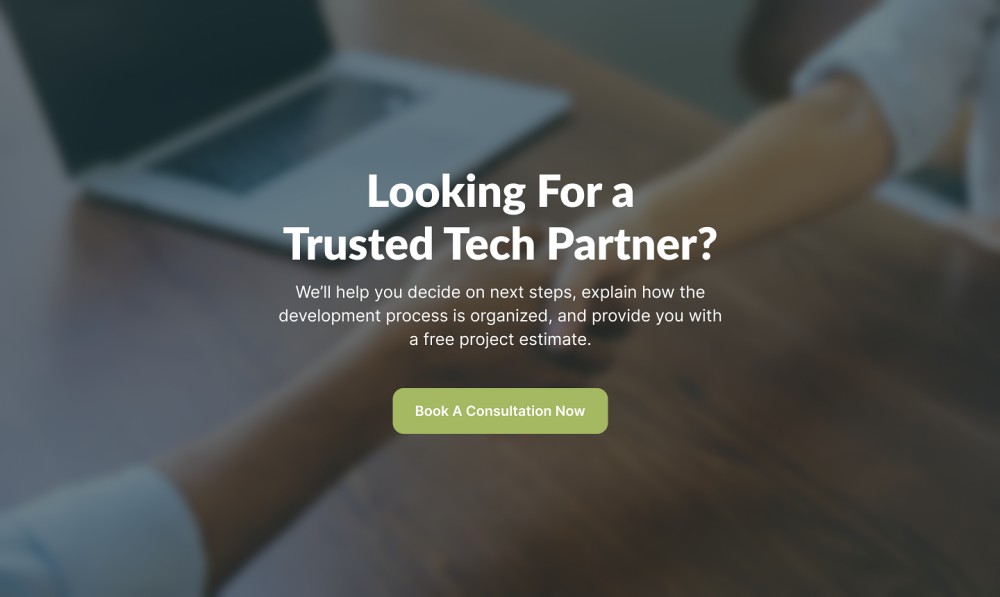The problem is that numerous factors can influence app development costs. Do you want to create an app that works on both iOS and Android? What country do you want to hire a development team from? What kind of app do you want to create? The cost of your project will vary greatly depending on the answers to these questions.
As a trusted software development company, we have created over 100 mobile apps since the company first surfaced in 2009. Being a part of the Apple Consultant Network, our article speaks from our own experience. Let’s delve into the most influential factors influencing mobile app costs and provide real-world app cost examples.
With this information, you’ll be able to estimate the cost of developing your mobile app. Anyway, feel free to contact our managers for a more precise estimate or further consultation.
1. What Factors Influence App Development Costs?
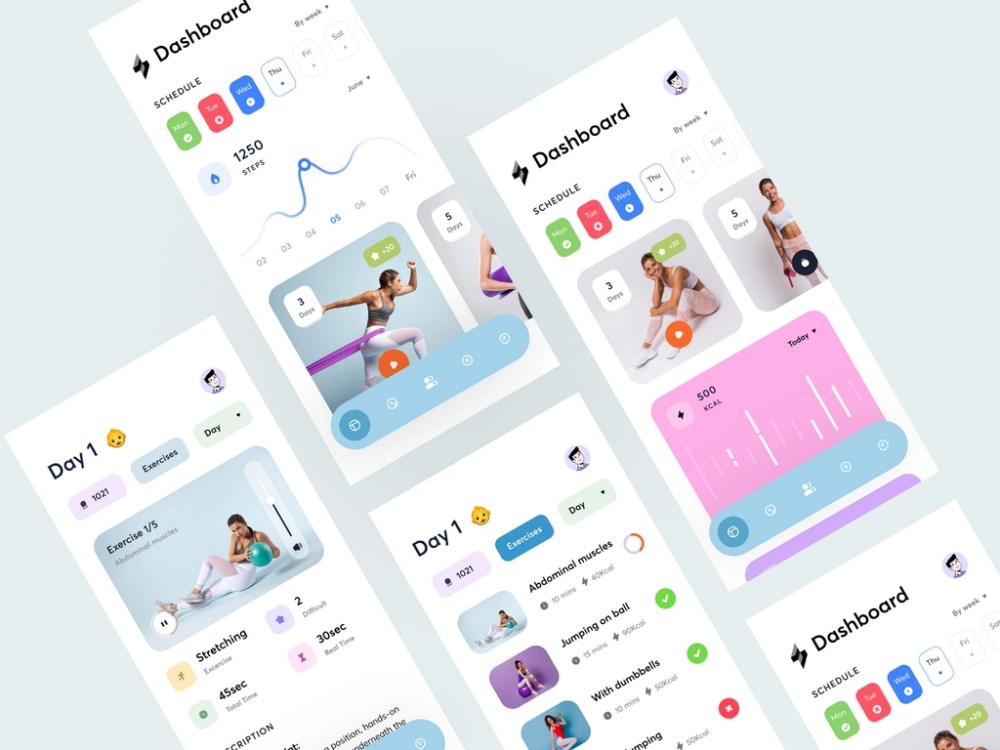
As with any complicated app development process, a variety of factors can influence the final cost. Here are the most important ones.
- App Types (native, cross-platform, hybrid)
- Platform (iOS, Android)
- Design
- Features/complexity
- Developer Rate (varies depending on location, hourly rate, and team size)
1.1. Android and/or iOS
Android and iOS are the two most popular mobile operating systems. They aren’t the only ones, but they rule the mobile world, with Android accounting for 69.74% of the market share and iOS accounting for 29.49% as of 2022, according to Statista.
When you begin working with a project manager on the first rough estimate for your app, one of the things you’ll research is the best platform to build for. What mobile devices does your target audience prefer? For example, 55.26% of mobile users in the United States use iOS, whereas in Poland, it is less than 10%. As a result, before deciding on an operating system, you must first research your target market.
You have three options if your customers use both iOS and Android devices:
- Select one platform for your initial app and add support for the other later.
- Create two apps right away.
- Create a cross-platform or hybrid app (more on those later).
If you choose one platform to begin with, the cost difference will be determined primarily by the length of development. iOS and Android development rates are roughly comparable.
Building an Android mobile app typically takes longer because your team will need to test on a wider range of devices.
1.2. Native, cross-platform, or hybrid app
When estimating the cost, the type of app makes the most difference. First, what exactly are these apps?
Native mobile apps are designed exclusively for a single mobile platform. It is impossible for a regular user to run an APK file (executable for Android) on an iPhone or an IPA file (executable for iOS) on an Android device.
Android and iOS use different programming languages and frameworks: Android uses Java and Kotlin, while iOS uses Swift and Objective-C. If your target audience owns both Android and iOS devices and you decide to support both platforms with native apps, you’ll need to create two apps: one for Android and one for iOS.
However, you can build a single app for both platforms (in addition to a web app or a responsive website):
- App for multiple platforms
- App hybrid
Cross-platform apps can be written in C# using Xamarin or JavaScript using React Native, while hybrid apps use AngularJS and its Ionic framework. All of these options are compatible with both Android and iOS devices.
You might be thinking right now. Why would I create apps for each platform when I could create a single app for both?
Indeed, developing a hybrid app is faster and less expensive than developing two native apps. However, you should be aware of the disadvantages that cross-platform and hybrid apps bring. Here is a brief comparison:
| Native apps | Cross-platform apps | Hybrid apps | |
|---|---|---|---|
| Pros: |
|
|
|
| Cons: |
|
|
|
Despite these disadvantages, there are some popular cross-platform and hybrid apps, such as Skype, Slack, and Instagram. The trick is determining what type of app your company requires. Perhaps the disadvantages will be irrelevant to your application. But perhaps they will.
1.3. Cost of App Design
Great visuals are the foundation of a good app, so it’s no surprise that design can influence the cost of developing an app. Custom icons and design elements, such as screens, logos, and buttons, will take time and money to create. In addition, each screen in an app must be drawn separately. Making custom animations is an entirely different challenge, but they are frequently a winning feature.
However, great design does not always imply complex visuals. Sometimes simplicity is the best solution: depending on what your app does, it may be possible to use standard OS-provided elements that don’t take much time or effort to compose.
When it comes to games, design is an especially important component of the cost of mobile application development.
Have a Project Idea in Mind?
Get in touch with Savvycom’s experts for a free consultation. We’ll help you decide on the next steps, explain how the development process is organized, and provide you with a free project estimate.
1.4. Features
The cost of developing an app is largely determined by the number of features — but this is not the only factor.
The complexity of those features can be more influential at times. Some features rely entirely on standard tools and APIs. Others necessitate the use of third-party APIs. A third type necessitates the development of custom algorithms.
It’s something of an industry standard to divide mobile apps into three categories based on complexity:
- Simple apps have few features, most of which are either fairly standard or relatively simple to implement. Consider this type of app to be a minimum viable product (MVP), or an app with only the features necessary to collect feedback and validate the app idea. Some finished apps are similarly straightforward. Building a simple app can take between 2 and 4 months and cost between $18,000 and $60,000.
- Medium-complexity mobile apps typically take 6 to 10 months to develop. Apps of medium complexity have more screens, features, and complex features than simple apps. If a simple app has a basic login feature, for example, a medium-complexity app would have Facebook integration. That’s just a simple example, but you get the idea. The cost of developing a medium-complexity app will most likely start at $50,000 and can rise to around $130,000.
- Complex apps include features such as augmented and virtual reality, bots, payment integration, NFC (near-field communication), and media streaming. Development time can range from 7 months to more than a year, depending on the number of such complex features. The average cost of developing an app with complex features starts at $130,000 and can reach $500,000 or even more.
1.5. Backend
The backend, also known as the server-side, is the part of your app that is invisible to your users but supports some of the more complex features, such as device syncing and push notifications (though the latter can be handled by cloud integrations today). Servers host your databases, custom, and third-party APIs, and other applications.
A backend isn’t required, but if your app requires one, you’ll need to hire a separate developer, such as one who works with Ruby on Rails or Python. And, of course, that developer will raise the price of your app.
1.6. Workload
When asked, “How much does it cost to develop an app?” The answer is typically calculated based on the amount of time required for analysts, developers, designers, and testers to complete all stages of development. However, developers’ work can be calculated in two ways:
- In hours, which is the traditional unit of measurement for task complexity. Developers estimate the time required to build each feature, allow for unexpected complications, then total the time for all tasks and multiply it by the hourly rate. Easy.
- In story points, a system that is increasingly being used in Agile development. The idea behind the story points system is that instead of attempting to predict how long it will take to develop a specific feature, the feature (or story) is assigned a number of points for difficulty.
Story points are subjective. The team chooses the simplest story (one with the fewest risks and the least amount of effort) and assigns it to two story points. Then all of the other stories are compared to it and given points in comparison. Typically, stories begin with two points. Not 1, because something is always added or removed during development, and a story worth fewer points than the one previously thought to be the smallest may appear.
1.7. Team Size
It’s difficult to estimate the average cost of developing an app without knowing how many people are involved. After all, these are the people you’re paying to do the work.
The simplest app development team consists of the following specialists:
- There is one project manager.
- 1-2 platform developers (iOS, Android, web)
- 1 backend programmer (optional)
- 1 user interface/user experience designer
- 1 quality assurance specialist
A single UI/UX designer is usually sufficient for both iOS and Android apps, but an additional web app may necessitate its own designer. A backend developer is required if your app requires a server-side.
This team can be expanded for faster and more complex development, which will impact app development costs.
1.8. Outsourcing vs. Internal Team
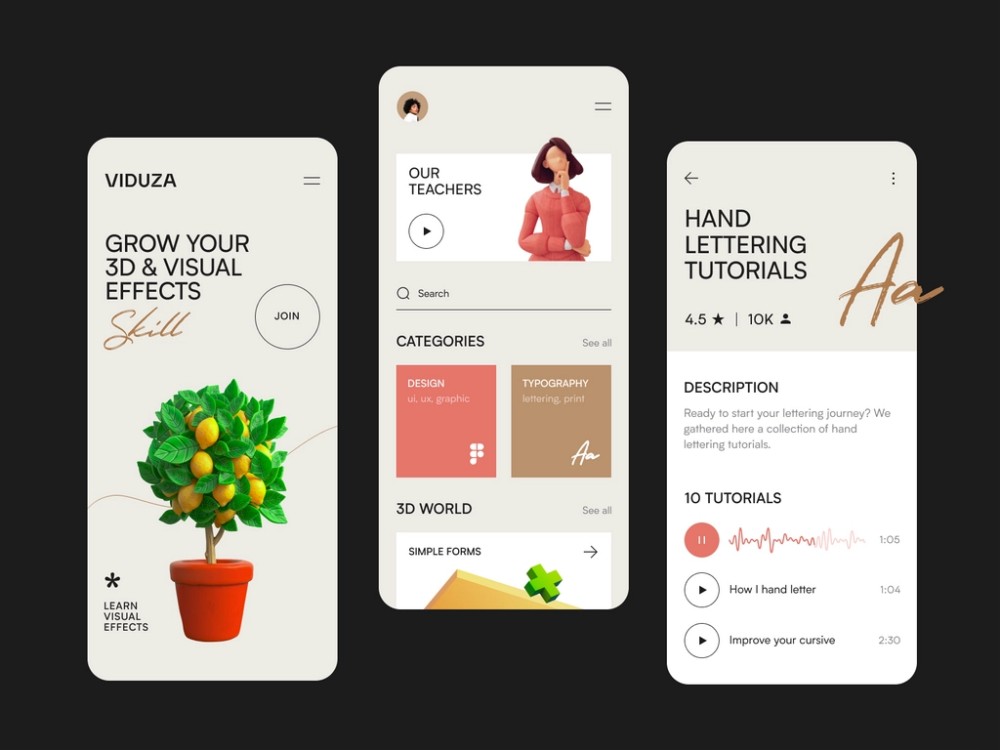
Hiring a team of specialists to sit in your office and work solely on your project is what in-house development entails. Outsourcing means hiring a separate company to do the development for you without having the developers within arm’s reach.
Both options have advantages and disadvantages, but we’ll concentrate on the price differences here. To make a long story short, hosting a team of developers in-house is far more expensive than outsourcing. Having an in-house team means you’ll be paying for the followings:
- Salaries
- Taxes
- Additional office space and workstations
- Software and hardware
- Tools for developers
- Everything you pay for your regular employees’ social benefits and everything else
These costs vary greatly depending on where your office is located. Even general numbers are impossible to state. An in-house team is sometimes justified, especially if you have multiple mobile products that must be constantly updated. In other cases, outsourcing is a better option. And outsourcing can be calculated with some accuracy.
Never Miss a Deadline with Savvycom
Get in touch with Savvycom for a free consultation. We’ll help you decide on next steps, explain how the development process is organized, and provide you with a free project estimate.
1.9. Development Team’s Location
The geographical location of the company you’re hiring accounts for the majority of the cost of outsourcing. Here is a list of countries organized by average hourly rates, from the most to least expensive:
- North America (the United States and Canada) – $100-150 per hour
- $110 per hour in Australia
- Western Europe (the United Kingdom, Germany, and Austria) — $90 per hour
- $50 per hour in South America
- Eastern Europe (Poland, Ukraine, Romania, and Bulgaria) — $40-50/hour
- $25 – 30 per hour in Asia (Vietnam and the Philippines).
- Egypt, Kenya, and South Africa — $30 per hour
We can estimate the average cost of developing an app in different regions using these approximations. To accomplish this, we simply need to go back in time and recall the average development time for each of the three types of apps:
- Small app for at least two months
- Average 6 months for a medium app
- 8 months to more than a year for a complex app
2. The Unknown Costs of Mobile App Development
The cost of developing an app extends beyond the development process. There may (and almost certainly will) be additional expenses to consider along the way. Here are the five most common hidden costs you may not have considered.
2.1. Upkeep and upgrades
The app’s release is undeniably significant, but it is not the endgame. As long as the app is available in app stores, you must maintain it, respond to user feedback, and provide regular updates. According to the Outsystems Survey, the cost of app maintenance during the first year after launch is approximately 50% of the cost of app development. The second year is usually 25%, and each subsequent year is 15-25%.
Maintenance and updating services typically include the following:
- Optimization of code
- Server enhancements
- Application updates and bug fixes
- New technologies and features
- Support for new operating systems
- Scalability of the app
2.2. Infrastructure expenses
These costs are primarily associated with app hosting on servers. The main goal here is to ensure that your platform can handle traffic spikes following the launch. The scalability requirements of your app will determine the cost of these services. Here is a list of infrastructure fees you may be required to pay:
- Server
- Storage of data
- Content distribution networks
- Integrations
- Tools for development
- Load balancing devices
2.3. Functional expenses
This section’s services are designed to help your app’s functionality. For example, you may need to subscribe to several services and set up third-party integrations. The cost of these services varies according to how many you require, and these expenses frequently include:
- Notifications via push
- Notifications via SMS
- Integration of social media
- Geolocation
- Gateways for payments
2.4. Level of app security
While you can completely delegate the development process to the hired team, there are a few aspects we recommend familiarizing yourself with, one of which is security. You can inquire about the development team’s security practices and discuss the best options for firewall protection, secure transactions, and other critical issues. Making the platform as secure as possible may increase the cost of developing an app, but it is well worth the investment.
2.5. Patenting applications
This legal step will protect your intellectual property rights while also assisting you if other app owners falsely accuse you of intellectual property theft. This must be completed before the app is released to the public.
During the patent application process, you will need to specify what makes your app unique, define the aspects of your app that you want to claim ownership of and provide a visual representation of the app.
The cost will vary depending on the country in which you file your patent application and the type of mobile app. A regular non-provisional patent in the United States, for example, can cost between $2,000 and $5,000.
Looking For a Trusted Tech Partner?
We’ll help you decide on next steps, explain how the development process is organized, and provide you with a free project estimate.
3. App Development Cost Examples
As evidenced by the preceding, so many factors influence the development process that estimating the cost of creating an app on the spot is difficult. At Mind Studios, we write articles in which we share our insider knowledge of the development of various types of apps, including cost estimates.
Here are several examples of the costs of developing an app for both iOS and Android in 2022, as estimated by The Mind Studios with their $45/hour rate:
- FitBit-like fitness app — $84,600
- Tinder-like dating app — $108,470
- Discord-like VoIP app — $99,950
- $82,440 for an educational app similar to Udemy
- Signal-like messaging app — $100,080
- Headspace-style meditation app — $76,590
- Postmates-style food delivery app — $130,500-148,500
- IKEA Place-like augmented reality furniture app — $91,800-124,200
- $137,700-162,000 for a marketplace app like Etsy or eBay
How much does it cost to create an app you have in mind, and how can you find out? If you know exactly what you want to build, you can either contact an app development company for a rough estimate (which is what our contact page is for) or use an online app cost calculator.
Online cost calculators are straightforward web applications. They allow you to select from a variety of parameters and features, and then automatically calculate a rough estimate based on the rates set by the calculator. When using one, keep in mind that the majority of these calculators estimate the cost very, very roughly. Most are designed to obtain your email address and entice you to contact the development company.
4. Mobile App Development Cost – Interesting Facts
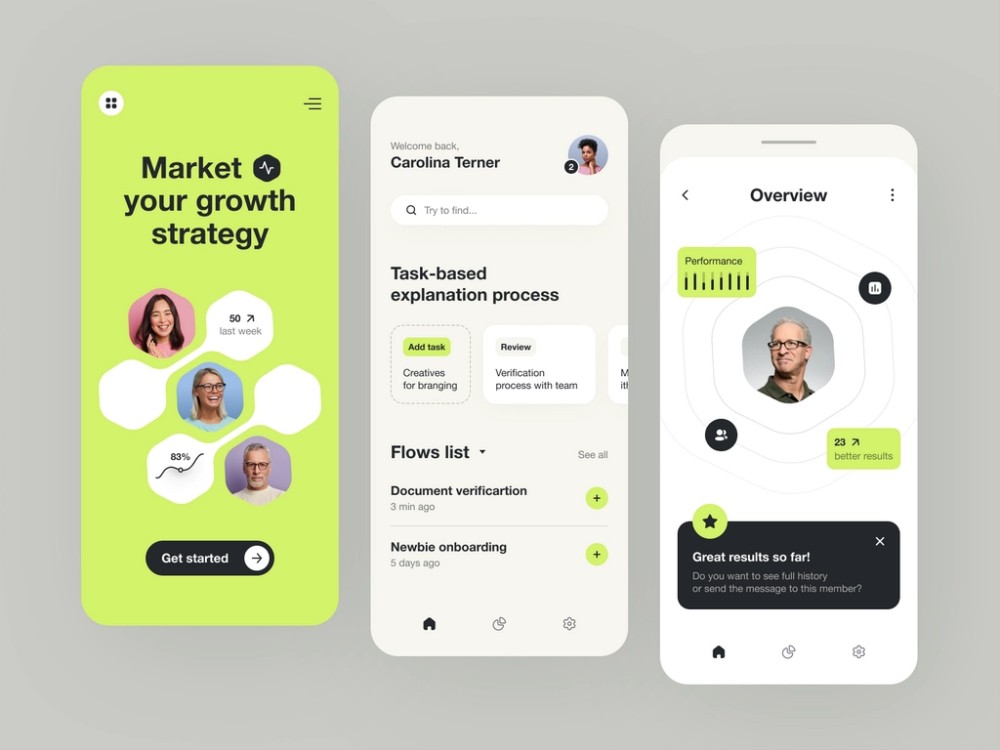
As you may have guessed, when we said numerous factors influence app costs, we weren’t exaggerating. And it’s not just the app development options that matter. Post-launch marketing and maintenance costs, economic conditions in the leading software service providers’ countries, and the evolution of the mobile app market all have an impact on the costs to launch a mobile app.
We’ve compiled a list of statistics about app development costs and the mobile app market in general that you may not be aware of.
- According to the Business of Apps, you should set aside at least $10,000 to plan your app’s go-to-market strategy.
- The cost-per-install (CPI), which is the price the app marketer pays to engage one user, can be used to calculate the cost of marketing. The iOS CPI in 2021 was $3.6 per app install, while the Android CPI was $1.22 per app install. Overall, app marketing can cost up to half the cost of development during the first year after launch.
- The average cost of maintaining software and, in particular, applications is approximately 15-20% of the cost of development.
- According to an Outsystems survey, more than 80% of mobile apps take 3+ months to develop, and 40% of applications take 6+ months to develop.
- According to Market Research Future, the mobile app development market will grow at a compound annual growth rate of at least 23.80% over the next eight years.
- According to Globe Newswire, the global mobile applications market is now worth US$ 112.6 billion and is expected to be worth more than US$ 307 billion by the end of 2031.
Given the last two forecasts on the list, it appears that the global mobile app market will continue to evolve at a rapid pace over the next decade, implying that app development costs will not decrease. So, if you’ve been thinking about creating your own mobile platform, now is the time.
5. Mobile App Development Costs by Types
So, how much money does it take to launch an app? To answer this question, the development team must first understand the type of application you wish to create. There is no one-size-fits-all solution, but each type of mobile app has a standard set of features that will allow the team to create a rough estimate for the project quickly. In the table below, we’ve compiled a list of some of the most common app types. Remember that the estimates are based on a $25 hourly rate.
| Type of app | Examples | Timeline | Average cost |
|---|---|---|---|
| Basic app with a minimum number of features | Video player, calculator | 1 month | $8,000+ |
| Data-driven app | Weather | 1 month | $8,000+ |
| Authentication app | McDonald’s Loyalty App | 3 months | $20,000+ |
| Social networking app | Instagram, Facebook | 3 – 9+ months | $20,000 – $100,000+ |
| eCommerce app | Etsy, eBay | 6 months | $60,000+ |
| Marketplace app | Amazon, Booking.com | 6 – 9 months | $60,000 – $100,000+ |
| On-demand app | Uber, Postmates | 8 – 12 months | $70,000 – $100,000+ |
| eLearning app | Duolingo, Udemy | 4 – 6 months | $40,000 – $60,000 |
| Healthcare app | Headspace | 5 – 8 months | $50,000+ |
| IoT app | Nest, Garmin Connect | 4 – 6 months | $40,000 – $60,000+ |
| Video Streaming App | Netflix, Hulu | 6 – 9 months | $60,000 – $100,000+ |
| Mobile Banking App | HSBC | 6 – 9 months | $20,000 – $100,000+ |
| Fintech App | Coinbase | 4 – 6 months | $30,000 – $60,000+ |
These are only a few of the most common types of mobile apps. If you have an idea for something unique and even innovative, please contact our business development team. We will gladly listen to your idea and answer all of your questions.
6. How to Reduce App Development Costs
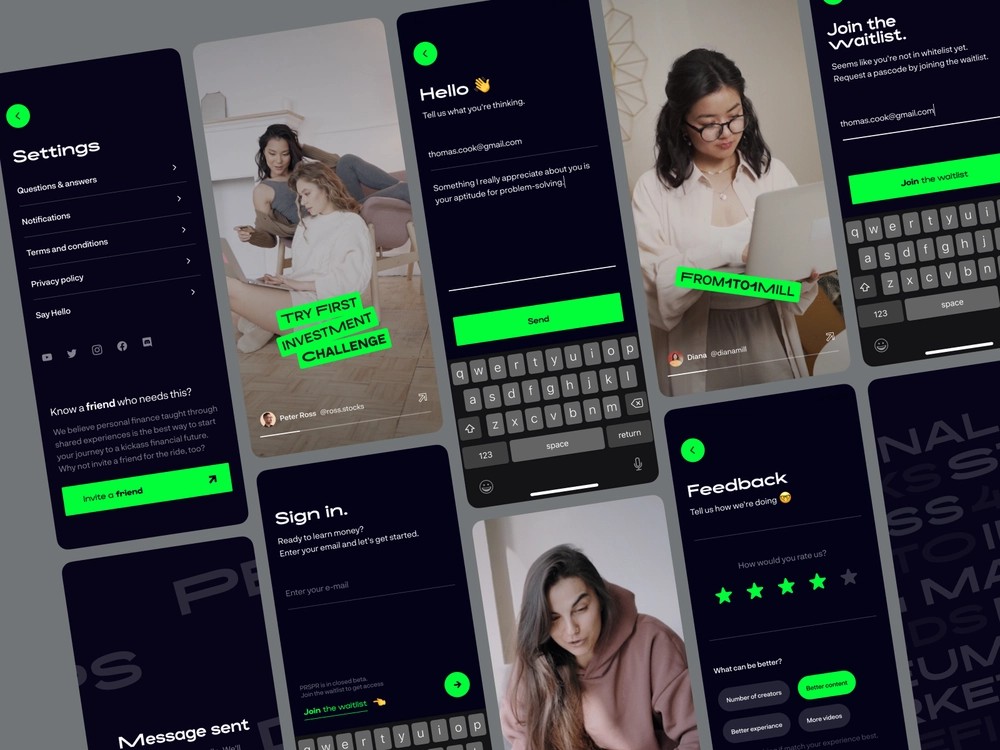
If the prices listed above make you nervous, here’s a list of seven things you can do to cut the cost of mobile app development.
- Make a thorough plan
Can you draw it? Better yet! Bring a clear idea and a way to properly explain it to developers.
Make a list of the app’s technical specifications and requirements.
This can prevent miscommunication, nervous breakdowns, and financial loss. In our previous article, we discussed the significance of requirements.
- Outsource
Using outsourcing development services is significantly less expensive than hiring an in-house team, especially if you hire a team from a region with reasonable hourly rates.
- Beginning with a test
Although it may appear obvious, not everyone does this. Early testing helps you find bugs that, if not fixed quickly, can lead to more bugs in the future, necessitating the rework of entire features.
- Create an MVP/MLP
A minimum viable product, also known as a minimum lovable product, can assist you in gathering data and avoiding mistakes long before you launch.
- Maintain regular contact with developers and check on progress
This will keep you and your team on the same page and help you avoid major mid-development changes or adjustments.
- Find a reliable mobile app development company
It is sometimes better to pay a little more for a development team that is experienced in your field and has a good reputation. Examine previous projects and reviews on professional websites such as Clutch.
Looking For a Dedicated Team?
A Dedicated Team might be the best solution in your case. Get in touch with us and we’ll help you choose the best IT outsourcing model based on your business needs and requirements.
7. How to Precisely Estimate App Cost?
At Savvycom, we estimate the cost of app development in six stages:
- You get in touch with us and tell us about your project.
- We are contacting you to gather general information.
- Our project managers conduct preliminary research and develop a rough estimate.
- We will contact you with our estimate.
- If everything is in order, we will begin a more in-depth discussion with you about the functionality and content of your app.
- Based on all available information, we create a more precise estimate.
After the final app development cost estimate, there may be adjustments if new features are added or additional technology is required. Slight cost adjustments are possible with any changes. However, the cost rarely deviates significantly from the final estimate.
Before app development begins, reputable software development firms will usually provide you with a rough estimate of the mobile app development cost. The quote is based on your project description, as well as your business and technical needs. This data is compiled and summarized in a preliminary list of features.
It’s also worth noting that initial estimates and actual application development costs don’t always match up. Aside from the obvious assumption that the estimate was incorrect in the first place, another common cause of the mismatch is a change in the app development scope. This can occur if:
- Midway through the project, the client decides to increase the number of features or make other significant changes.
- The MVP launch or soft launch, during which initial feedback is gathered, indicates that the team needs to make some significant changes or even look for entirely new solutions.
Fortunately, in most cases, these disparities can be avoided by investing time and money in the proper discovery stage. That is the first thing Mind Studios does after accepting a new project. During the discovery stage, we determine whether there is a market need for the app, which features the target audience will require, and how we can differentiate the new product from the competition.
8. App Cost By Stages of Development
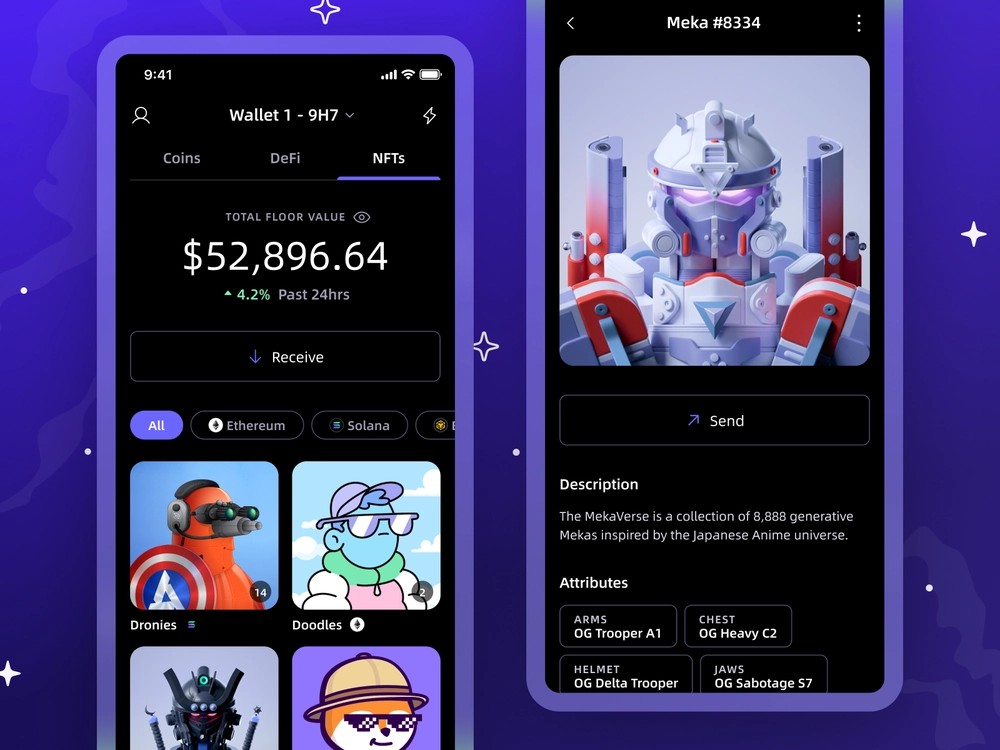
The entire app development process can be broken down into four major stages. Let’s look at how much each of them might cost and how much of the overall process they compensate for. Remember that the calculations below are based on a $25 hourly rate and apply to medium-complexity projects like an on-demand delivery app or a fitness app.
- The discovery stage is when the team analyzes the market and the target audience, calculates the risks, and develops solutions that will help the app succeed.
Time and cost estimates: 80 hours, $2,000 - The UI/UX design stage is when a team of UI/UX designers decides on the app’s features and develops its visual concept. The outcomes of this stage are presented in the form of prototypes — visual mockups of each app screen.
Time and cost estimates: 160 hours, $4,000 - The development stage is when a team of developers turns the prototypes into a fully functional mobile application. The following estimate includes iOS, Android, and backend development.
Time and cost estimates: 2080 hours, $52,000 - Testing is the process by which QA engineers test the app and look for bugs to report to the development team so that they can be fixed.
Time and cost estimates: 200 hours, $5,000
The project management component is an additional important component of the overall development cost. It is not a stage in and of itself, but rather a tool that assists the client and team in staying on the same page throughout the collaboration. This service takes 200 hours on average and costs $5000 for a medium-complexity project.
9. Conclusion
There are numerous factors that can influence the cost of developing a mobile application, including whether it is native or cross-platform, simple or complex, and developed in North America, Asia, or Eastern Europe. Even with the statistics on app development costs in 2022, making an accurate estimate without knowing the specifics of the project is difficult. However, in this article, we’ve covered the most common types of mobile apps on the market, so you can get an idea of how much your project might cost.
If you’d like a more accurate estimate for a mobile app, our business development team will gladly conduct a free consultation for you.
Savvycom – Your Trusted Tech Partner
Savvycom specializes in tech consulting, end-to-end product development, and software outsourcing, utilizing digital technologies to support business growth across diverse industries. With a focus on delivering high-quality software solutions and products, we also offer a wide range of related professional software development services customized to meet your specific needs.
Savvycom is right where you need. Contact us now for further consultation:
- Phone: +84 24 3202 9222
- Hotline: +84 352 287 866 (VN)
- Email: contact@savvycomsoftware.com
2. How Does A Software Development Firm Estimate The App Development Cost?
Savvycom follow 6 stages to estimate the total costs, this is also the common process for other firms:
Stage 1. A client gets in touch with Savvycom about their project.
Stage 2. We contact our client to gather general information about them and the project.
Stage 3. Our project managers conduct preliminary research to develop a rough estimate.
Stage 4. We discuss with the client our rough estimated cost for the project.
Stage 5. Then, we carry out an in-depth consultation and discuss the app's functionality and design.
Stage 6. With all the information, we can deliver a more precise estimated cost for the app development project.
3. What Are The Estimated Costs For A Simple, Average and Complex App?
As discussed in the article, development costs are impacted by many factors. Thus, the costs may vary widely.
If the rate is $40/hour, here is how much to pay for an app:
- Simple app: $40,000 to $60,000
- Average app: $60,000 to $150,000
- Complex app: from $300,000
In case you want to reduce the costs, it is suggested to outsource from countries like Vietnam. You will be able to own an app with the same quality but for a more affordable price.
4. Tips To Reduce App Development Costs?
Building an app is not cheap, but there are several ways to get around it and lessen how much you need to pay.
1. Make a detailed plan
List out clearly what your app will need, what it serves, your strategy, and your budget for the project.
2. Outsource
Outsourcing is a clever way to save money, especially if you hire a team from a region with more reasonable rates.
3. Test frequently
It is advised you test your app as soon as possible to find bugs and fix them before they require more effort.
4. Create an MVP/MLP
A minimum viable product (MVP), also known as a minimum lovable product (MLP), can assist you in gathering data and avoiding mistakes long before you launch.
5. Contact your developers & check on the progress frequently
Doing this keeps you and the developer team on the same page and helps you avoid major mid-development changes.
6. Find a reliable mobile app development company
Cutting costs is a goal for any business, but sometimes it is worth paying a little extra to get the quality product you desire.
If you’re thinking about doing anything like this or a start-up owner who just happens to be interested in Mental Health App Development, keep reading for tips, recommendations, and obstacles.
1. Mental Health App Market Overview
The state of mental health in America in 2023 is pretty concerning. According to Mental Health America:
- 21% of adults are experiencing mental illness – equivalent to 50 million Americans.
- 55% of adults with a mental illness in the United States require treatment that is currently unmet.
- 16% of youth report suffering from one or more major depressive episodes in the past year, equivalent to 2,7 million people. But 60% of them didn’t receive proper treatment.
- According to statistics, people suffering from mental health disorders constituted 20.6% only among US citizens.
- Depression leads to mental health illnesses in 3,8% of the population, and the figures are about to increase as people’s concern about psychological issues have risen by over 28% in Europe and the US.
- Cost is one of the key reasons people couldn’t access mental health services.
On a global look, the statistics are also raising great attention:
- 322 million people worldwide live with depression (The Zebra).
- Almost 800 million people are suffering from mental health disorders.
- The number of women who experience depression is twice the rate of men.
The pandemic has pushed individuals even more into a mental health crisis. Many people have had to deal with depression, anxiety, stress, or any other mental health problems when they have to stay home for a long period of time without interacting with the outside world.
Also according to an article from PRNewswire The development of mental health apps revenue will grow by 23.7% between 2019 to 2027.
Why Are Mental Health Apps So Popular Today?
Mental health has been at the forefront of the public’s attention in recent years. And the pandemic has only contributed to our already high levels of anxiety. According to Kaiser Family Foundation research, the number of adults in the United States suffering anxiety and/or indicators of depression doubled during the epidemic.
While the importance of mental health is becoming more widely recognized, many people are still hesitant to seek help from a therapist. There are numerous reasons for this:
- People cannot afford long-term treatment.
- Individuals can’t see a therapist regularly due to a lack of time.
- A lack of flexibility and the need to rearrange one’s schedule prevents the person from accommodating sessions.
- Finding a decent therapist is a difficult task.
- Some countries have limited access to therapists.
- Societies still view counseling as something only for “crazy” people and “lost causes.”
- People fear being found out and mocked for having a mental illness.
- An apprehension that a therapist will withhold mental health information.
- Many people feel awkward discussing profoundly intimate problems with a stranger.
Most of the concerns listed above are solved, at least in part, by mobile apps. Mental health applications provide greater flexibility and reduce the need to travel to a therapist’s office. It’s also easier to hide trips to a counselor using an app than hide visits to a counselor. The fact that individuals can have online sessions also makes them feel more relaxed in sharing their information. Not only that, it helps people to access treatment at a more affordable cost.
All of the above reasons explain why mental health app development is necessary for society.
2. Types of Mental Health Apps
Mental health is a broad topic, and no software can pretend to cover everything there is to know about it. Any software, whether an app or a website, should not do so – too much information and functionality do any service, be it an app or a website, clumsy and difficult to use.
Instead, it’s more practical for both users and developers to create mental health apps that fall into several categories. Customers benefit from categorization since it allows them to identify suitable solutions more quickly. The following types can be used to categorize mental health apps:
2.1. Mental Disorder Apps
Mental disorder apps are designed specifically for users fighting severe illnesses like depression, bipolar disorder, obsessive-compulsive disorder (OCD), posttraumatic stress disorder (PTSD), eating disorders, and schizophrenia. Apps of this kind usually use proven treatment methods, including cognitive behavior therapy (CBT), mood monitoring, mindfulness, and cognitive skills training.
Digital psychological help providers have significantly changed the mental health niche, offering alternatives to traditional therapy appointments or clinical treatment. Many patients can now feel free and secure with a 24/7 online doctor on their smartphones. Profound medical monitoring and live person–therapist communication make treatment easy for both parties.
MoodTools, MoodKit, Talkspace, and Happify are believed to provide valuable opportunities for dealing with depression. These are excellent examples of mental health app development as they were designed with the help of therapists and coaches.
2.2. Mental Self-Improvement Apps
Self-improvement apps aim to check general psychological health and relieve slight problems like stress, anxiety, negative thinking, frustration, and bad habits. These apps bet on meditation techniques or connect users with psychologists to ensure proper self-care solutions.
a. General Mental Health Apps
General-purpose apps specialize in maintaining users’ self-care via mood control and successfully implementing healthy habits. Mental health app developers may include varied features in their products, such as specified questions, community features, and checklists.
The best examples of creating a mental health app for this purpose are What’s Up and 7 Cups of Tea.
For $150 per month, 7 Cups offers customers self-care guides, 24/7 chat with volunteers, and confidential communication with licensed specialists. Simultaneously, the What’s Up app provides a variety of self-care activities to help people cope with stress, anxiety, anger, and other negative emotions.
b. Apps for Addiction Recovery
Fighting bad habits on one’s own can become an unbearable load, so many people need external help to healthier their lives. Apps supporting addiction recovery provide trackers, helpful info, daily reminders, meditations, sharing experiences, and a supportive community. Good mental health apps for addiction recovery include Twenty-Four Hours a Day, Quit That!, and Squirrel Recovery.
c. Stress and Anxiety Apps
Stress, frustration, and anxiety stand among the most common problems modern people experience. Thus apps helping to tackle these issues are in high demand. With numerous relaxation techniques and effective motivational plans, services guarantee positive results that make their users feel comfortable again. The best applications to overcome stress are CBT Thought Record Diary, Mind Shift, Stop, Breathe & Think, and Smiling Mind.
|
Educational resources |
Online libraries offering mental health-related materials; self-assessment apps |
|
Mental health trackers |
Apps that track users’ emotions sleep patterns, habits, and symptoms. |
|
General-purpose self-help apps |
Stress and moderate anxiety apps, as well as meditation and mindfulness apps |
|
Mental disorder self-help apps |
Apps aimed towards reducing the symptoms of one or more common mental illnesses. |
|
Teletherapy apps |
Apps that transfer treatment sessions from offline to online |
|
Therapy supplement apps |
When a therapist is involved, trackers and self-help applications are used to treat problems (and can provide therapists access to a user’s data). |
|
Apps connecting patients |
Apps resemble social networks or forums where persons with mental illnesses can share their stories and connect with others. |
3. How To Develop Mental Health Apps?
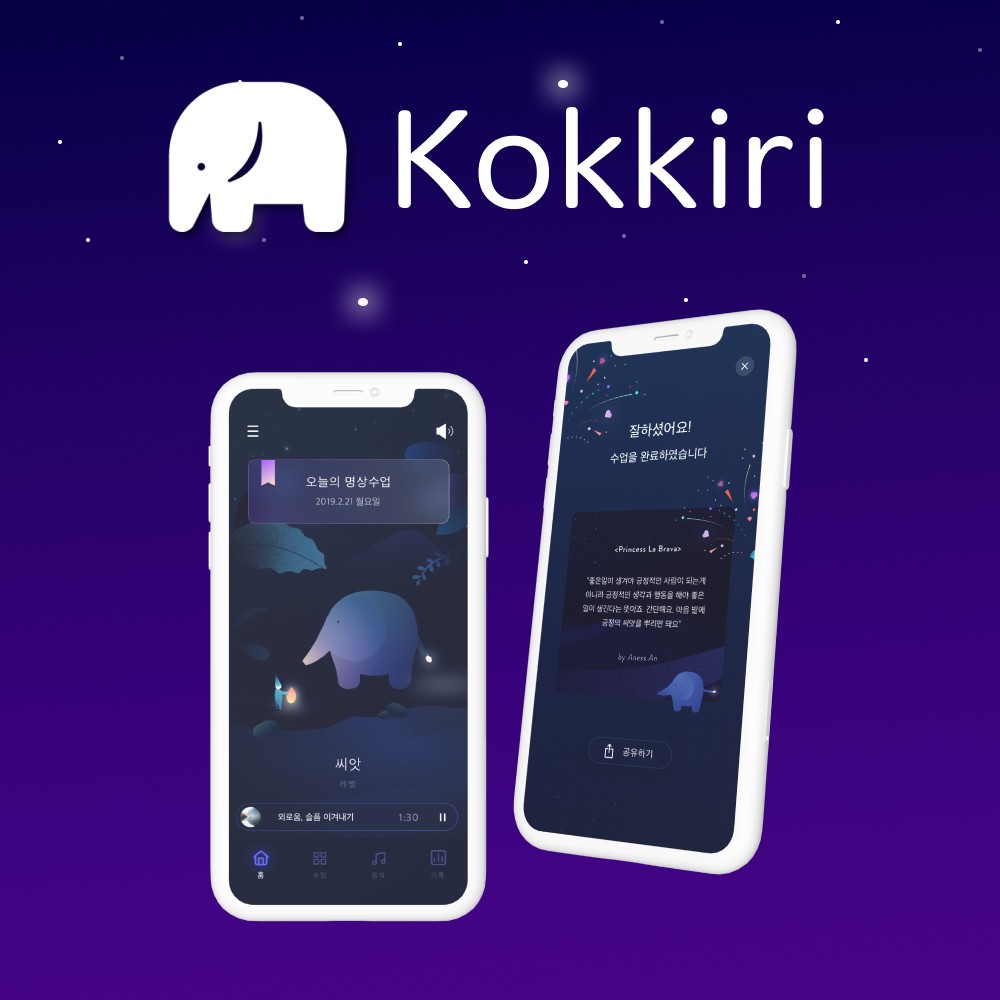
We’ve developed a tried-and-true method for creating a mental health mobile app throughout the years. Here are the major steps to take from an idea to a successful launch and specific cautions to be aware of in the healthcare market.
Step 1: Discovery Phase
When developing a mental health app, it’s critical to have a clear vision of the type of app you want to make. You can start by answering the following questions:
- Is mental health the primary issue that the software addresses, or is it a side issue?
- Will your software cater to a specific user group?
- Will your app focus on a specific mental health issue, or will it be a general-purpose software that helps people maintain a healthy mind?
- Will you make a stand-alone app or one that works in conjunction with in-person therapy?
- What kind of app do you have in mind?
Do you want to build a digital library, an assessment app, or an app that actively helps patients with features like meditation, mood tracking, and self-confidence affirmations? Or are you planning to develop a teletherapy app?
- Who is the intended audience for your app?
To find the market fit, you must first understand your target audience. Specific mental health concerns are more prevalent in certain demographics. You can make a mental health app for children, teenagers, the elderly, LGBTQ+ persons, immigrants, and others. You might also choose to target the broader public.
- Is your software a stand-alone application?
Although severe problems necessitate the assistance of a specialist, an app can still be utilized as a supplement. Apps that track medications, moods, and routines might be used between therapy sessions or during breaks. If designed as treatment supplements, these apps can provide therapists with access to a patient’s data (with the patient’s consent).
Step 2. Conduct Competitor & Market Research
Approximately 20,000 mental health apps are available in app stores. Although it is not the most significant section of the mobile app market, the fierce rivalry is. One of the most important steps in developing a mental health app is to examine how others have succeeded and failed.
Of course, studying all 20,000 competitors isn’t essential. It’s always a good idea to look into the most successful applications in your sector, but it’s also good to look into a few apps that failed because they might teach you something.
You can use competitor analysis to identify the best and worst practices in your niche.
Step 3. Create A Detailed Plan
A business plan summarizes the study you did to develop a mental health app. Writing a comprehensive business plan will assist you in visualizing what you want to build and how you want it to function.
As you work on your app, you’ll definitely make adjustments to your business plan, but it’s crucial to have as complete a picture as possible before you begin. This will cut down on trial-and-error errors, speed up time to market, and lessen the cost of developing your mental health app.
Step 4. Find The Right Developers
If you’re building an app from scratch, you’ll need to hire:
- Android and/or iOS developers
- Server-side developer
- UI/UX designer
- Quality assurance specialist
- Project manager
You can find separate freelancers, or you can hire an IT outsourcing company for a software app development services.
However, keep in mind that medical apps are challenging in ways that require more than just technical knowledge. There are legal dangers specific to mobile apps in the IT healthcare solutions sector and recommendations from health experts, and requirements from health authorities. This is why we advocate enlisting the help of experts who have worked on health-related apps before.
Step 5. Build An MVP
Launching a minimum viable product (MVP) allows you to complete the following objectives:
- Save costs
- Acquire your first users
- Test the application on users who aren’t developers
- Earn early revenue
- Enhance brand recognition before the full launch
Because an MVP is a condensed form of an app, it is less expensive and faster to develop, and launching your app with the promise of expanding and upgrading it can help you make income and establish your brand online. If you have your own practice, this money can develop further, and online recognition can lead to offline clients.
However, the most significant advantage of an MVP is the opportunity to get honest feedback from users who are interested in the app. When developing an app to assist people with mental problems, feedback is even more vital. A disruptive UX or sluggish performance will be even more of an issue for users who come to your app to feel calmer than it would be for the average user in other sorts of apps.
Step 6. Monitor & Analyze Performance
Whether you release an MVP or a full product, the launch is only the beginning of your app’s journey; there’s still much work to be done.
For a mobile app to remain relevant, it must be updated and improved regularly. And, in order to create updates that are beneficial to your audience, you’ll need to understand what keeps users coming back and what drives them away.
You’ll be able to make better decisions about prioritizing features, updates, and sales techniques if you track user engagement numbers.
Step 7. Marketing Campaign
It’s difficult to exaggerate the value of marketing in terms of app performance. To attract users, you’ll need to advertise your mental health app wisely, even if it’s one-of-a-kind — perhaps it takes an original approach or offers a unique combination of features.
There are a number of ways to market your mental health mobile app, but we have narrowed them down the some of the most significant:
- Social media advertising
- App store optimization
- Content marketing on your company’s blog and on third-party platforms
- Press coverage in relevant publications
- Hiring influencers to advertise your app
- Noticeable presence on social media and mental health forums
Your marketing team will assist you in selecting a suitable strategy and marketing channels for optimum exposure based on the behavior and expectations of your target audience.
Step 8. Continue To Update Your App
Any app that does not receive upgrades and updates and those that do not keep up with advances and trends will eventually become obsolete. That’s why it’s critical to keep track of your mental health app’s performance, make data-driven improvements, and roll out updates to keep users engaged after it’s launched.
4. How Do Mental Health Apps Make Money?
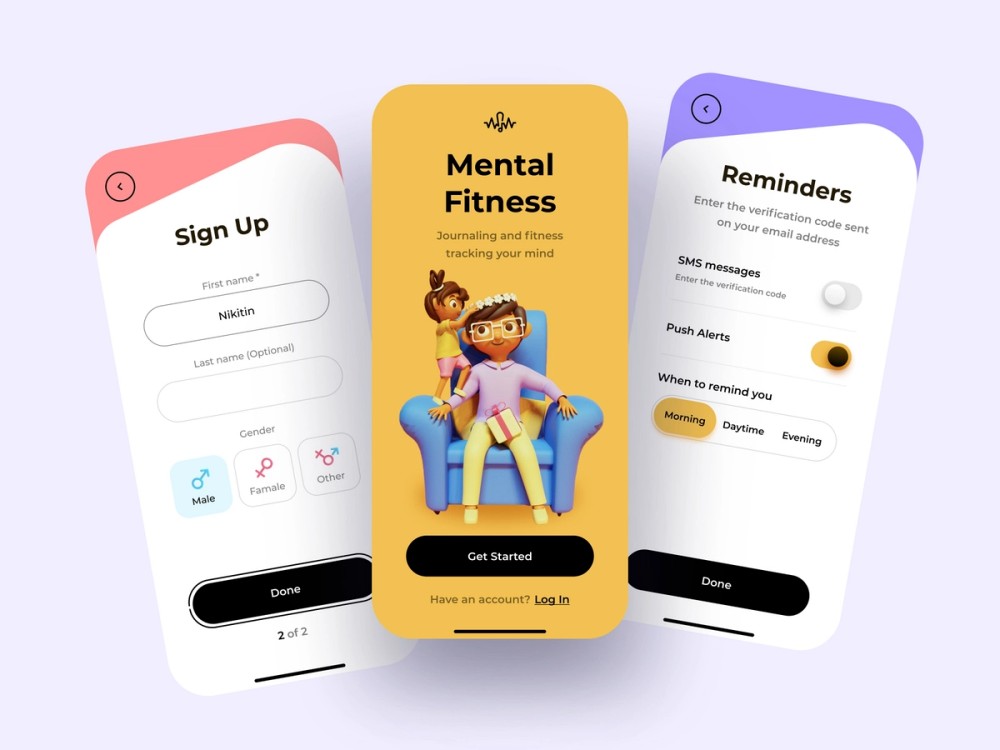
Just like any other apps out there, these are the monetization options you can choose from for a mobile app:
- Ads
- Subscriptions
- In-app purchases
- Freemium
- Paid downloads
Ads are not suggested for monetization in mental health apps due to the unique nature of the experience and the risk of agitating users.
Users may find in-app purchases irritating if there is a lot of material that must be purchased individually.
If your company is directly involved in providing mental health therapy and you already have a reputation and strategies to obtain app users from your clients, paid downloads are a viable choice.
The following are the two most common monetization options:
- During the trial period of subscription-based apps users often receive access to all content. The trial period for prevalent mental health applications can last up to two weeks.
- The freemium model allows users to access some content for free while paying for access to the full scope of information through a subscription or a one-time purchase.
- Paid downloads provide more money at once but not overtime, whereas subscriptions provide a minor but constant money flow. The optimum monetization model will be determined by your business model.
-
You can also advertise and sell things through internal links that display similar products such as books, podcasts, or workshops.
5. Mental Health App Features & Notices
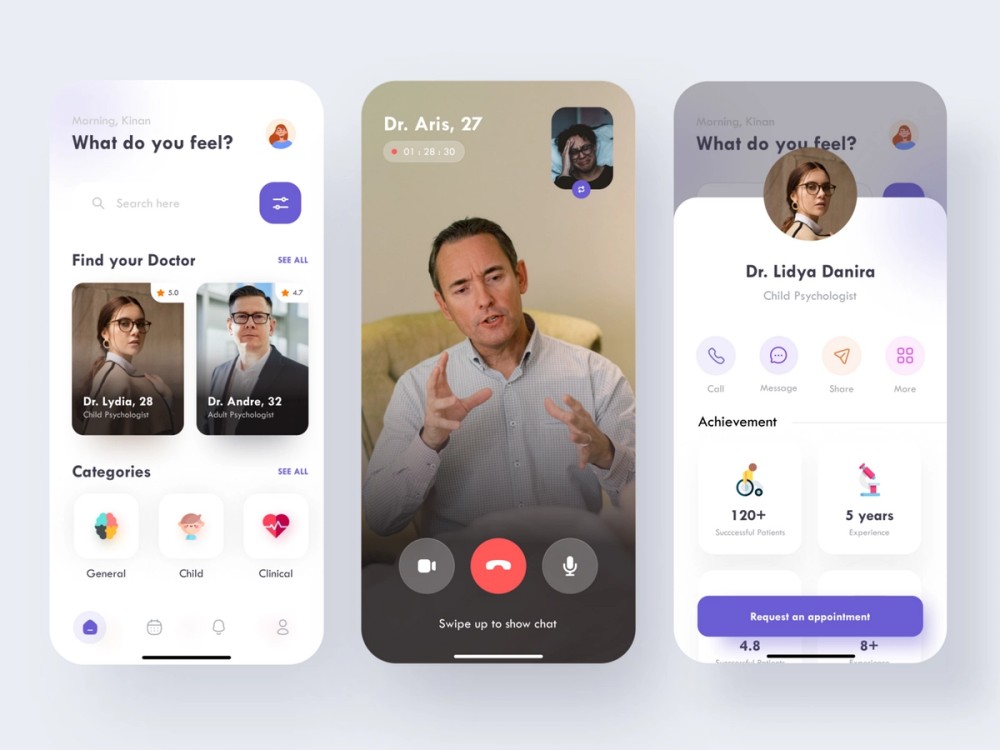
Some of the elements listed below may be more significant than others, depending on the type of mental health app you’re creating.
5.1. Onboarding
It’s critical to take your consumers through the program step by step, describing the features simply but clearly. You might want to explore using animated “assistants” to add some emotion and care, and you can engage a professional to design your instructions in a way that considers your users’ individual needs.
5.2. User profile
Shortcuts to key elements like user data, progress, most-used features, and settings should be kept in a user profile.
5.3. Settings
It’s critical for users of mental health apps to be able to customize their experiences. Users should be able to customize the volume and frequency of notifications, select a theme (if one is available), and so on.
5.4. Notifications
Push notifications can be used to remind users of upcoming tasks or gently entice them to open the app by asking how their day is going.
Have a Project Idea in Mind?
You are more than welcome to contact our Partnership Manager for a free consultation.
5.5. Meditation
Meditation and mindfulness are frequently advised for anxiety, post-traumatic stress disorder, or panic attacks. Audio for guided or unguided meditation can be added to your app’s functionality.
5.6. Mood Tracking
A mood tracker is beneficial for persons who suffer from depression, bipolar disorder, or other mood disorders. Users can gain some control over their conditions and possibly address mood-altering causes by recording their moods.
5.7. Journaling
Journaling is frequently associated with mood tracking, and for some people, it can serve as a substitute for meditation as a relaxing activity.
5.8. Sleep Tracking
Sleep disorders are common in people with a variety of mental health issues. You might include a simple tracker or a more comprehensive one that allows users to note suspected causes of tiredness or insomnia (e.g., medication, agitating activities).
5.9. Medication Reminders
If your app is for mental health conditions that require medicine, adding customizable reminders for users to take their medications will be advantageous.
5.10. Trigger Checkers
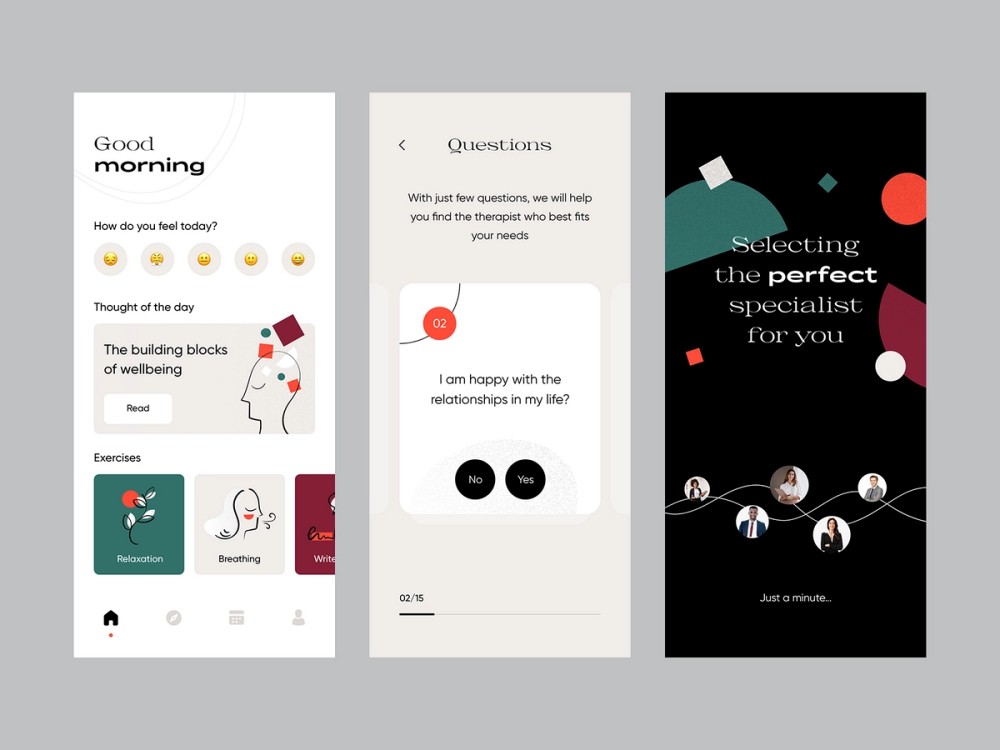
Users can cope with their disorders by writing down the triggers that produce anxiety, panic attacks, or depressive episodes.
5.11. In-app Support
Many apps benefit from chatbots that handle issues, but for those who are battling with mental health, genuine and competent human assistance is a superior option because the human mind is too complex for bots to comprehend.
5.12. Community Features
Peer support can be the most valuable resource available to someone experiencing or recovering from an episode. Patients can cope better if they know they’re not alone.
5.13. Gamification
Switching focus away from triggers to an eye-pleasing game can help people relax. We do, however, advise care when it comes to gamification: competitive games or leaderboards might negatively impact users’ spirits.
5.14. Affirmations
Inspiring quotes and affirmative words can lift a person’s spirits and aid in the fight against despair and anxiety.
5.15. Favorites
Allow users to save their favorite features or information for quick access from their profile or home screen, reducing the user journey and improving the user experience.
5.16. Matching Patients & Therapists
For teletherapy apps, you’ll need the ability to connect users with therapists depending on the problem they’re having and the therapists’ qualifications, fees, and schedules.
Looking For a Trusted Tech Partner?
We’ll help you decide on next steps, explain how the development process is organized, and provide you with a free project estimate.
5.17. Dashboard For Therapists
A therapist dashboard is required for apps that connect therapists with patients. It will also require its own set of features. It might also be a separate app with a back end that connects to the patient app.
5.18. Sharing
Sharing moods and/or activities on social networks or messengers functions similarly to community features in that it fosters a sense of belonging and encourages individuals who care about the user to offer assistance.
5.19. Artificial Intelligence & Machine Learning
Because it can offer activities and content tailored to users’ habits and tastes, machine learning can make your mental health app more engaging.
5.20. Admin Panel
You’ll need an admin panel to add or update content and monitor activities. The most common format is a simple web page.
6. Factors To Consider For Your Mental Health App Development
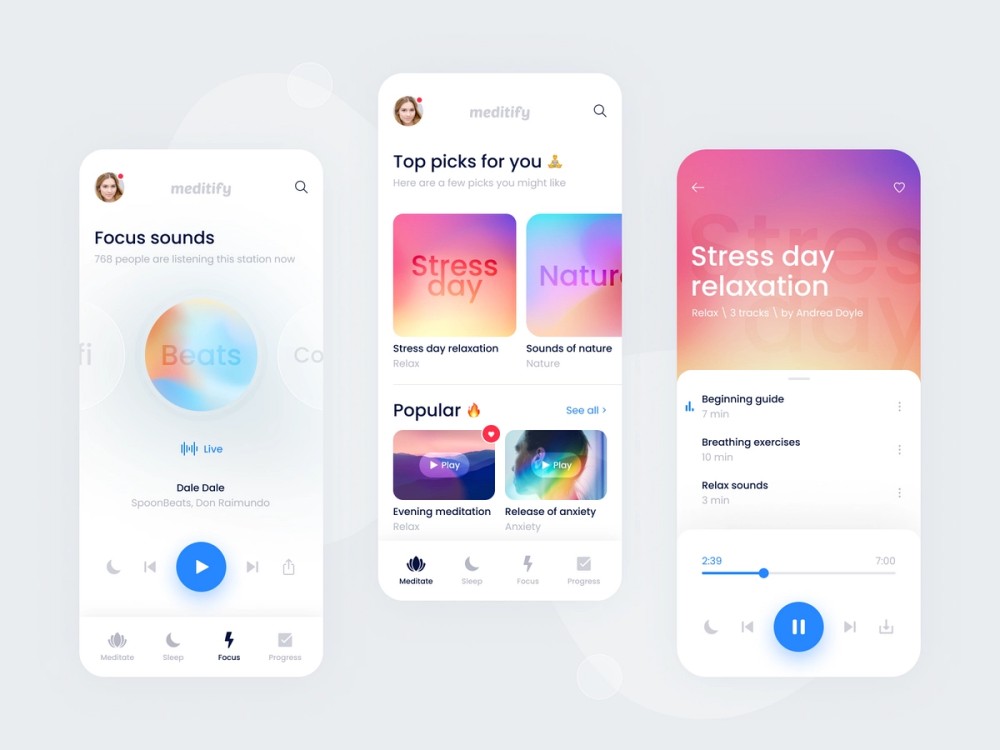
Workflow Automation
Mental health apps reduce the workload for care providers thanks to the process’s automation. So ensure your app’s workflow is optimized for the best performance.
Automation can be applied to these parts of the workflow:
- Patient registration
- Appointment booking
- Patient interviews before appointments
- Daily symptom control
- Payment process and confirmation
- Prescription clarification
Security Enhancement
Data security is probably the most important aspect that a mental health app needs to attend.
There are numerous options available to provide high-level security.
- Multi-factor authentication (password, security token, biometric verification like fingerprints, face ID, voice recognition, one-time passcode, phone call verification, personal security questions).
- End-to-end encryption – a type of encryption in which no one can read the messages transferred except the sender and the recipient.
- Fingerprinting. This function is intended to identify a patient’s device (that includes the operating system, screen size, IP address, location, time, language, etc.). A user is notified if certain indications unexpectedly change.
- Real-time fraud notifications. Keep users updated about fraud cases so that they can actively protect their information.
Regulation Compliance
Know how to design a compliant mental health app if you want to make a successful one. To protect user privacy, different countries have enacted essentially identical standards and regulations.
- USA – Health Insurance Portability and Accountability Act or HIPAA
- European Union – General Data Protection Rules or GDPR
- United Kingdom – Data Protection Act
- Canada – Personal Information Protection and Electronic Documents Act
They want to make sure that developers are also aware of privacy and data sharing issues while learning how to make a mental health app. Because a medical record or history is personal to a person, it must be protected and safeguarded.
7. How Much Does It Cost To Develop Mental Health App?
In this article, we’ve shown you a variety of mental health-related apps. And it would be a lie to claim that there is a single price that applies to all of them. However, we can provide estimates for development timelines and required specialists, which are the two aspects that have the most impact on costs.
The team you’ll need to develop a mental health app consists of:
- Project manager
- UI/UX designer
- Android developer
- iOS developer
- Backend developer
- 2–3 quality assurance specialists
A mindfulness app with extensive features like monitoring, analysis, audio content, and a bespoke admin panel, in our experience, can take a year to develop and cost anywhere from $80,000 to $150,000. However, we’re talking about an entire app, not an MVP.
A simplified self-assessment app can be constructed in two to five months (depending on the complexity of the evaluation) and will thus be much less expensive.
| Light Up Your App Ideas With Savvycom | ||
|
Didn’t find what you looking for? Contact Us Now |
||
Savvycom – Your Trusted Tech Partner
From Tech Consulting, End-to-End Product Development to IT Outsourcing Services! Since 2009, Savvycom has been harnessing the power of Digital Technologies that support business’ growth across the variety of industries. We can help you to build high-quality software solutions and products as well as deliver a wide range of related professional services.
Savvycom is right where you need. Contact us now for further consultation:
- Phone: +84 24 3202 9222
- Hotline: +84 352 287 866 (VN)
- Email: contact@savvycomsoftware.com
How can I ensure that my mental health app is engaging and encourages regular use?
To make your mental health app engaging and encourage regular use, consider incorporating elements such as gamification, rewards or badges for achieving goals, progress visualization, personalized recommendations, push notifications for reminders or encouragement, and interactive features like quizzes, challenges, or habit trackers.
What platforms should I target for my mental health app?
The choice of platforms depends on your target audience and market research. Consider developing your app for both iOS and Android platforms to reach a wider user base. You may also explore web-based versions or compatibility with wearable devices, depending on your app's functionalities.
How can I ensure that my mental health app is effective?
Conducting rigorous research and evaluation is crucial to ensure the effectiveness of your mental health app. Collaborate with mental health professionals to validate the app's content and interventions. Conduct usability testing with potential users to gather feedback and make improvements. Track user outcomes and engage in data analysis to assess the app's impact on mental health indicators.
Are there any ethical considerations in mental health app development?
Yes, there are several ethical considerations in mental health app development. These include obtaining informed consent from users, ensuring confidentiality and privacy of user data, providing accurate and evidence-based information, considering potential biases in algorithms or content recommendations, and being transparent about the app's limitations and potential risks.
How can I market my mental health app effectively?
Marketing your mental health app effectively involves understanding your target audience, identifying their needs and pain points, and positioning your app as a solution. Utilize digital marketing strategies such as social media marketing, content marketing, influencer partnerships, app store optimization, and targeted advertising. Engage mental health professionals and organizations to raise awareness and credibility for your app.
What are some important considerations when developing a mental health app?
Developing a mental health app requires careful attention to several important considerations. Here are some key factors to keep in mind:
- Privacy and Security: Mental health apps often deal with sensitive and personal information. It is crucial to prioritize user privacy and implement robust security measures to protect user data from unauthorized access or breaches.
- Regulatory Compliance: Familiarize yourself with relevant laws and regulations, such as HIPAA (Health Insurance Portability and Accountability Act) in the United States, if your app handles protected health information. Ensure that your app complies with these regulations to maintain legal and ethical standards.
- User Experience and Design: Design an intuitive and user-friendly interface that enhances user engagement and makes it easy for individuals to navigate the app. Keep in mind that mental health users may be experiencing emotional distress, so create a visually appealing and calming design that promotes a positive experience.
- Evidence-Based Content: Ensure that the mental health app provides accurate and evidence-based information. Collaborate with mental health professionals to develop content that is reliable, trustworthy, and up-to-date.
- Customization and Personalization: Every individual's mental health needs are unique. Consider providing features that allow users to personalize their app experience, such as customizable goals, reminders, or personalized content recommendations.
- Data Analytics: Implement analytics tools to track user behavior, app usage patterns, and outcomes. This data can provide valuable insights for improving the app, identifying user needs, and enhancing mental health interventions.
- Collaboration with Mental Health Professionals: Engage mental health professionals in the development process to ensure the app aligns with established therapeutic approaches. Their expertise can help shape the app's features, interventions, and overall effectiveness.
- Integration with Existing Mental Health Systems: Consider integrating your app with existing mental health systems, such as electronic health records (EHRs) or teletherapy platforms, to facilitate seamless communication and continuity of care.
- Accessibility: Ensure that your app is accessible to a wide range of users, including individuals with disabilities. Follow accessibility guidelines and offer features like text-to-speech, adjustable font sizes, and color contrast options.
- Continuous Improvement and Updates: Mental health app development is an ongoing process. Collect user feedback, monitor performance metrics, and regularly update and improve the app based on user needs, technological advancements, and emerging research.
1. Mobile App Development in 2022 – Yes or No?

In 2020, when going digital is the only way businesses can continue to operate seamlessly due to the effect of the global Pandemic (Covid-19), many SMEs, entrepreneurs, and startups are yearning to launch their mobile apps to bridge the gaps between them and the clients while making the most out of digitalization.
The mobile app industry is unquestionably thriving and enticing as mobile user and mobile app usage have increased exponentially for the past year. It is safe to say that the Mobile App Market is a never-ending pie that everyone wants to have a bite at some point on the way. Pointing out some outstanding numbers is also easy as the projected revenue from mobile app downloads, in-app purchases by 2023 will reach a whopping $581.9 billion, stated on Statisa. And if that wasn’t convincing enough, we have a few more numbers that we would like to show you.
- App stores saw a record 204 billion app downloads back in 2019.
- And according to Statista, by 2021, there will be roughly 7 billion mobile users worldwide.
- Mobile App downloads are expected to go up to 258 Billion by 2023.
Learn More On: The Essential Guide To Software Development Services
So no matter what industry it is, the next step for business owners, startups, and enterprises has transitioned to go “Digital”. Sure the process can cost a lot and may take some time to finish, but the business benefits of building a mobile app are more than enough to compensate. The top functional and marketing benefits of business mobile applications are as follows:
- Direct Communication
- Geo-Targeting Marketing
- Increased Recognition
- Better Customer Loyalty
- Website Creates Awareness And The App Makes The Sale
- Improved Customer Engagement
- Boosts Brand Recognition
- Improved visibility
However, there are many mobile app development companies worldwide, which makes it tricky to choose the best mobile app development company to help you go mobile. For you to make the right choice, I have curated a list of the 10 Best Mobile App Development Companies in Vietnam that are absolutely worthy of your attention. If you are wondering why you should find a trusted Tech Partner in Vietnam, we have another extensive article for it.
2. Vietnam – Ideal Destination For Offshoring
01. Pandemic Stabilization
Recognizing that its medical system would soon become overwhelmed by even mild spread of the virus, Vietnam chose prevention early and on a massive scale. The country reported one of the least cases in Southeast Asia with minimal deaths. We are also featured in various reputable newspapers for our relentless efforts and successful pandemic countermeasures. This has given businesses based in Vietnam a head start over global competitors at this time.
Update 16/5/2022:
- Over 80% of Vietnam’s population has been fully vaccinated.
- Vietnam has dropped the Covid-19 test requirement for foreign arrivals from May 15
- The recovery rate is 87.5%, while the Fatality rate is only 0.4%
02. Cost-Effectiveness

According to Innotech, outsourcing software development in Vietnam costs 50% less than the rivals from India and China. Anderson Vietnam also estimates that outsourcing per person in Vietnam is only $20,000 per person a year compared to $40,000 per person in India. These figures are convincing enough to place Vietnam as the top future contender for offshore development projects.
As Indian companies enter the maturing cycle, the cost differential between India and Vietnam will increase even further. The outsourcing costs in India are most likely to increase in the coming years.
03. Potential Workforce
Human capital in Vietnam is witnessing positive trends. Some of the most notable highlights in Vietnam IT workforce in recent years are:
- Top 7 countries in Asia with the highest EF EPI Average.
- Top 5 countries in Asia with the fastest improvement in English skills.
- Top 10 countries in the world with the most engineering graduates.
- Top 10 countries of origin of international students in key study-abroad markets.
- Top 10 countries in Asia Pacific with the highest Human Capital Index.
- Top 10 in regional groups in global attraction and global knowledge skills.
- Top 30 countries in the world and top 2 in SEA countries for basic academic skills.
Moreover, Vietnam has a population of over 90 million people and over 60% of the population is under 30 years of age. With that being one of the countries with a young population, the Vietnamese – or Vietnamese workforce specifically – are perceived to be fast learners, dynamic, innovative, tech-savvy and flexible to changes.
04. Knowledge & Skills

As the surge of technology is making a significant impact on every generation, more and more STEM majors, schools and academies are opened to encourage the young to invest their talents in technology and relevant sectors and hone their skills. The rapid development in both quantity and quality of IT education in Vietnam provides an extensive supply of software developers for Vietnam outsourcing companies in the years to come.
On the other hand, Vietnam students are often appraised for their fast absorption of knowledge, most of them have good to excellent academic background as certified by standardized exams, endorsements from global recruiters, honours and awards.
05. Vietnam’s Developers Ranking
|
Skillvalue 29th worldwide in developer skills charts of skillvalue’s report 2018 |
Topcoder Top 6 worldwide in developer skills charts of topcoder report 2016 |
|
Hackerrank 23rd worldwide in developer skills charts of hackerrank’s report 2016 |
AI Development The first two scientific researches at neurips – top 1 conference in the world about artificial intelligence in canada from artificial intelligence research lab vinai research |
Workers in Vietnam have extensive English language training. Because the majority of the software engineers you’ll be hiring are college graduates, they’ll have attended English classes throughout the years and will most likely be fluent in English already.
With that said, it is considerably easier to outsource to other countries when you have solid English communication abilities. If you want to work in software engineering or business process outsourcing, you should have excellent communication skills.
3. Top 10 Software Development Companies In Vietnam
01. Savvycom
Savvycom presents “The Art of Coding” – When artists meet coder
If people were to ask, “Which company is the best at App Development in Vietnam,” it would not be an exaggeration to say that it’s Savvycom. Throughout 2021, the Savvycom team remained one of the top app developers on both Clutch & The Manifest and belonged to the top leading Software Development Companies in Vietnam. Founded in 2009 and under the leadership of Ms. Thanh Van Dang – Asia Society Distinguished Fellow, Savvycom has carried out the mission of leveraging engineering resources in Vietnam and empowering businesses worldwide by utilizing the power of technology for over a decade.
The team at Savvycom is fueled by a pay-it-forward mindset and a creative approach to technology. The company provides excellent full-stack solutions to many industries, including insurance, finance, healthcare, education, logistics, blockchain, etc.
The company’s successes are reflected in its 150+ endorsements from clients, including Fortune 500 companies, in its receipt of more than 20 international honors and awards, and its strategic partnerships with technology brands such as Apple, AWS, and Microsoft.
| Learn More About Savvycom: | |
| Savvycom Profile |
The Manifest: |
| Dribbble | |
| Behance | |
| Ms. Van Dang – Linkedin |
Most recent : |
02. CMC
CMC Global is a subsidiary of CMC Corporation with the goal of bringing Vietnamese ICT products, solutions, and services to the international market. They are proud to be one of the leading companies in Vietnam in providing a wide variety of comprehensive IT Solutions & Services, ranging from traditional services to Digital Transformation and Telecommunication, as well as Consultancy, to organizations worldwide, having been established in March 2017 as a strategic move by the Corporation to enter the global stage.
Learn More About CMC Global On:
03. Sotatek
SotaTek is a part of Sota Holdings, a global Software Development as a Service (SDaaS) & IT Consulting group. Their 500+ team offers experts who bring Digital Transformation approaches to achieve sustainable growth for enterprises of all sizes. In 2021, except for the Sao Khue Award, SotaTek has excellently won the hat trick of VINASA awards, including the “Top 10 Vietnam Information Technology Enterprises 2021 Award” and the “Top 10 Blockchain Services Providers Award”.
Learn More About Sotatek On:
04. Smart OSC
SmartOSC is a full-service e-commerce agency that was founded in 2006. Lotte, Courts, PayPal, Boozt, SpaceX, Smartbox, eWAY, Priceline Pharmacy, Club 21, Delta Apparel are among the company’s more than 500 global clients. SmartOSC has a global presence with 500+ employees and offices in Vietnam, Australia, Singapore, the United States, and the United Kingdom as of January 2017.
SmartOSC provides consulting, UI/UX design, development, and managed services, among other things. The technical and business expertise of the company is based on a few platforms: Magento, Sitecore, Adobe, Hybris, and Kentico.
Learn More About Smart OSC On:
05. Rikkeisoft
Rikkeisoft provides software services and solutions for clients worldwide, ranging from Web/Cloud Systems, Mobile Applications, Games, and Blockchain to AI, IoT, Business Processing, and Embedded Systems. Eight years since being founded in 2012, they have successfully established three branches around Vietnam and three affiliated companies. Rikkeisoft takes pride in building better lives through advanced technology for people. Their vision is to have 10,000 employees by 2025 and become one of Southeast Asia’s top Vietnamese software development companies.
Learn More About Rikkeisoft On:
06. Saigon Technology
Saigon Technology Solutions is one of Vietnam prestigious Tech Solution providers focused on delivering cost-effective solutions to its clients. Its customers are located in the US, the UK, Australia, Germany, and the Netherlands. Their services include custom application development, web application development, and mobile application development. It is listed among the top software development companies around the world. Additionally, Saigon Technology Team also provides .NET Core, Java, PHP, ReactJS, Angular, Azure, AWS, microservices, and machine learning. Some of its impressive clientele include Kaercher, Abbott, Panasonic, Topicus, and DMI Inc.
Learn More About Saigon Technology On:
07. Tpp Technology
In Viet Nam, TP&P is one of the leading, highly diversified, and pioneering IT service providers and investment management firms. TP&P applies its extensive experience and specialized knowledge to various technology startup investment and service provision strategies, including software development, development and cloud management, and business consulting.
Learn More About Tpp Technology On:
08. NTQ Solution
A Vietnamese based company, specialized in Software Consulting & Development. Founded in 2011 by a group of IT experts with great passion for technology, our company has been providing cutting edge engineering solutions, helping worldwide customers untangle their issues. NTQ takes pride in the quality of their work and constantly seek new ways to improve their know-how & capabilities.
Learn More About NTQ Solution On:
09. S3Corp
S3Corp prides itself on putting the client’s needs at the core of its operations. The company has been in the Vietnam tech industry for more than a decade. Through this period, it has worked with various companies and brands from across the globe, including Absolute Software, Change Lab 23, SingTel, Vinasa, Ruckus, HCA, Pepsico and Paradigm, among others.
With the team of talented software engineers, S3Corp provides full custom software development services, including full lifecycle development, new feature development, UX/UI design, web and desktop application development, mobile application development and driver/firmware. Additionally, it also provides automation testing for software products and product verification for assured quality and successful integration of custom software products into your business operations.
The company prides itself in utilizing some of the latest technologies and tools in the market today, thus guaranteeing products that are at par with the current and future industry standards. Further, the company has partnered with other recognized institutions in the tech industry, including Microsoft, ISO and SiteCore.
Learn More About S3Corp On:
10. Agile Tech
Agile Tech was established in 2015 in Hanoi, Vietnam. It specializes in web development, mobile app development, AI- big data services and blockchain services. Through its team of highly skilled software engineers and IT professionals, the company has built multiple software products for leading companies and brands in more than 10 countries.
The company’s portfolio provides sufficient evidence of the company’s proficiency and ability to serve multiple industries. Agile Tech has developed custom software products for enterprise management, e-commerce, social media and entertainment, Fintech solutions, Service industry, Travel and hotel, healthcare, real estate, education, transportation and lifestyle, among others.
Agile’s mission is to provide reliable technical solutions to enterprises to boost their business outputs. Guided by a mission to deliver successful and innovative solutions at reasonable costs and within short timelines, the company has earned the recognition and a spot at the top of the list of trusted custom software development companies in Vietnam.
Learn More About Agile Tech On:
Savvycom – Your Trusted Tech Partner
From Tech Consulting, End-to-End Product Development to IT Outsourcing Services! Since 2009, Savvycom has been harnessing the power of Digital Technologies that support business’ growth across the variety of industries. We can help you to build high-quality software solutions and products as well as deliver a wide range of related professional services.
Savvycom is right where you need. Contact us now for further consultation:
- Phone: +84 24 3202 9222
- Hotline: +84 352 287 866 (VN)
- Email: contact@savvycomsoftware.com
According to Statista, the mobile app market revenue reached a whopping $693 billion in 2021. However, it is only the beginning, as according to Gartner, only 0,01% of mobile applications actually succeed and manage to stay in the game. In this post, we will take a look at the latest Mobile App Development Trends trends, so you can ensure your next app is the one from 100 that turns out to be a great hit.
Learn About The Evolution of Mobile Applications

| The Year 2005 | Before we proceed to the current state of mobile solutions, it is essential to mention how far we have come. Starting from 2005, websites began to be designed for smaller displays and equipped with touchscreen-friendly interfaces. A couple of years later, native applications with gesture navigation had begun as businesses recognized the advantages of having a dedicated and reliable mobile solution. |
| The Year 2013 |
Around 2013, the popularity of mobile web applications had risen, and Websites were now capable of being accessed through a device’s browser. What is more, personalized technology was introduced – apps gained user personalizations like location, time, and pattern identification for a more personalized experience. Mobile web apps evolved into hybrid apps and were wrapped inside a native container providing access to native platform features. This led to an increased interest in voice technology to simplify human-to-machine interactions. |
| The Year 2019 | Since 2019 we have been living in an era of micro apps, which are consumer-oriented solutions that deliver highly targeted functionalities and personalized experiences with the help of artificial intelligence and machine learning. |
So, What Happened Last Year (2021)?

It is no exaggeration that people spend more time on mobile devices than on everything else. Statistically, more people own a cell phone than a toothbrush. Mobile devices generate 70% of traffic, and around 75% of emails are being opened on mobile devices. The ease of use and convenience of mobile devices have changed how we behave online and offline. According to Google, 80% of smartphone users are more likely to purchase from companies with mobile apps, and in a world where Covid-19 is still a concern in most parts of the world, people are even more inclined to stay home and buy things from Apps.
Statista goes even further and states that by 2022, App Store user spending will increase to $157 billion (up by 92%). In 2021, the mobile market is set to grow by 385%, and there will be about $7 billion mobile users worldwide.
However, in this dynamic and ever-evolving environment, apps that shined in 2020 may not have the same success factor in 2021. That is why incorporating the latest trends into your mobile app development strategy is vital to a company’s success.
Top Mobile App Development Trends To Watch Out For In 2022
01. 5G Technology Implementation

It is impossible to leave the 5G Technology out of the picture when it comes to the Mobile App Development trend. Despite being around for recent years, 5G has not yet become standard in many areas; however, it will by 2022. Many people are eager to try out the latest 5G connections and experience their seamless connectivity. According to PRNewswire Report, the global market for 5G infrastructure is forecast to increase from $12.9 billion to $115.4 billion between 2021 and 2026.
With the 5G connection lightning capabilities, which promises up to 1,000 times faster speeds than 4G, there are endless possibilities in both software ,and mobile app development industry. Developing apps that rely on technologies requiring faster connections to work correctly, such as AR and VR, will get a much-needed boost as 5G becomes all the more accessible to a larger audience. Moreover, the best part about the 5G network lies in its stability and less latency that enables users to watch for 4k resolutions and play games without any single trace of buffering or glitches.
02. Cloud-Native

Cloud-native apps are written with a cloud-first mindset, eliminating the need for a dedicated hosting server. Everything else is handled by cloud-native solution providers like AWS, Google Cloud, or Azure in the case of those apps. Google Cloud serverless tools allow automated scaling based on website traffic is one of the numerous advantages of cloud-native for developers and companies.
Interested In Creating An App?
Contact us for a free consultation on Software Development and you will get all of the insights from our professional technical perspectives. Our Developers will advise you on the best approaches to the development process, as well as roughly estimate your project concept cost.
03. AI & Machine Learning
After FaceApp’s unprecedented success, many people were left asking, “What’s next?” That’s when AI delivered something that blew my expectations out of the water. The MyHeritageApp includes a vital photo animate tool that transforms photos into realistic animations. These animations are so good that you get the impression that your loved one is smiling at you. It elicited some spectacular reactions.
It wasn’t the only exciting development in AI last year. Google also added new capabilities to its Maps app that employ AI to improve the user experience. One such feature is Live view, which allows users to navigate large indoor spaces using augmented reality. Google also utilizes AI to offer fewer carbon-intensive routes by optimizing directions for lower fuel usage.
AI and machine learning have been among the most popular mobile app development developments for the past few years. However, these technological breakthroughs have raised the standard for mobile app creation in 2022, and it will be intriguing to watch what the year delivers.
Machine learning is another promising subject where we expect to see groundbreaking developments. When Deep Learning and Machine Learning work together, they can provide valuable data and real-time insights for mobile app development initiatives.
04. Apps for Foldable Devices

Even though foldable devices account for a small portion of the entire smartphone industry, this will alter in the following years. In 2022, 50 million units will be shipped, according to Statista. As a result, it’s time to think about foldable devices as part of your mobile app development strategy. Ensuring that your apps work well on foldable smartphones could potentially be an excellent sign to users, showing you are ahead of the curve.
By simply increasing the screen size of video streaming and gaming apps or using the extra space to offer additional information and controls, foldable devices can reap maximum benefits. As a result, one of the leading mobile app development trends in 2022 will be building apps with the screen in mind.
05. AR & VR
Pokemon Go’s success was fleeting, but it cleared the path for augmented reality in smartphone app development. It demonstrated to the rest of the world that virtual reality could be used to provide users with an immersive experience. Today, if we look around, it’s not hard to see big brands using AR & VR to enhance user experience.
- Ikea uses AR to let users see how furniture will look at their home before buying it.
- L’Oreal has a virtual makeup app that allows users to see how the makeup looks on their faces.
- Microsoft Mesh is a collaboration and communications platform developed by Microsoft with the vision to unify holographic virtual collaboration across multiple devices, be they VR headsets, AR, laptops or smartphones”.
- The newer VR Headset Model from Oculus now works independently without the help of a Modern PC or Laptop.
Apple, Google, and Meta are all bringing AR and VR technologies to the market. In Google Maps, Google added a feature called “Live View,” allowing users to see the direction in real-time on real-world photos.
Another significant technological innovation in the world of AR that we’ve lately seen is LiDAR. Apple dubbed the technology AR at the speed of light, and it debuted since the introduction of the iPad Pro, iPhone 12 Pro, and iPhone Pro 12 Pro max. It’s taken augmented reality to a whole new level. It is now possible to take high-quality photographs in low light using LiDAR.
06. Wearable App Integration
Wearable technology has already taken over the planet. According to Statista, there were 453 million linked wearable devices in 2017 and 929 million by 2022.
In the wearable devices market, many noteworthy developments happened this year. Apple has released WatchOS 8 for the Apple Watch, bringing new features, new watch faces, increased wallet access, and a revised UI.
Even Google revealed a unified wearables platform that combines its Wear operating system with Samsung’s Tizen software platform, resulting in a 30 percent reduction in app startup times. It foreshadows the rise of wearable technology, which will be one of the most important mobile app development trends in 2022.
In other words, app developers and businesses should provide apps that deliver an exceptional digital experience to customers on Smartwatches and wearables in order to obtain a competitive advantage over those who do not. Take advantage of this mobile app development trend to get closer to your target audience by providing a seamless digital experience.
07. Mobile Entertainment & Gaming
Apps for entertainment and games have become ingrained in our culture. Some folks can’t imagine living without them for even a single day.
Netflix has roughly 74 percent active customers, in the United States and Canada, so we can predict how popular mobile entertainment apps are. Furthermore, with over 159.1 million mobile phone gamers, mobile devices are the most popular among gamers, accounting for over 89 percent of all digital gamers in the United States.
Popular Tech Giants like Tencent, Microsoft, and Sony have all recently acquired major gaming studios like Bethesda, Bungie, Activision, and Blizzard as following:
- Publisher Take-Two announced plans to pay US$12.7 billion for Zynga, the developer behind Farmville and Words With Friends, once the biggest titles on Facebook and mobile, respectively. Sony said it would snag Destiny developer (and former Halo developer) Bungie for US$3.6 billion.
- And on the same day the U.S. government announced new plans to rein in runaway digital age consolidation, Microsoft revealed its US$67.8 billion bid to buy gaming titan Activision Blizzard. In a move that dwarfs others, the Xbox maker is swallowing up what was already an absurd concentration of blockbuster titles, representing a sizable chunk of the global gaming market.
The Market for Entertainment and Gaming will surely be an exciting land to watch out for in 2022.
08. Food & Grocery Delivery Apps
As a result of the lockdown due to the Global Pandemic, people began gravitating toward applications that cover food, grocery, and other day-to-day products delivery services. One of the most popular apps in Southeast Asia is the Super app called “Grab” which aims to provide everything you need without stepping foot outside. As a result, these two app categories grew at the quickest rate in 2020 – 21.
According to Statista, sales grew by 80 percent from March to June before declining to 5.7 billion dollars in August. As of October 2021, online grocery deliveries and in-store pickups reached 6.4 billion U.S. dollars.
As we return to normalcy, we may notice a minor slowing in their growth. Food and grocery applications will continue to play an essential role in our lives. People will never stop ordering food online, and 15.5 percent of smartphone users will still use grocery apps.
Whatever the case may be, only time will tell. However, it will be interesting to watch how much road food and grocery delivery applications have progressed by 2022.
09. Mobile Wallets
Mobile wallets have grown in popularity among users, especially as economies worldwide shift to digital. People prefer to use mobile wallets such as Google Pay, Apple Pay, Amazon Pay, and others instead of cash or inputting credit card information for speedier transactions. Because the market has not yet reached saturation, there is still room for future expansion. Future trends in mobile wallets include:
- Audio-based mobile wallets
- Near-field communication (NFC) based payments
- Radio-frequency identification payments
10. Chatbots
Although current chatbots are far from flawless, they gradually make their way into our daily lives. They aid with the ordering process by automating repetitive user interactions such as answering simple inquiries like “is the store open.” Furthermore, more than half of purchasers say they want more self-serving customer service capabilities, and chatbots are an excellent method. According to statistics, 36% of Americans have used a chatbot, and with the popularity of Facebook Messenger, chatbot usage on mobile is increasing even more.
11. Virtual Events Streaming

The Weeknd Virtual Concert Drew Over 2M Viewers
Because individuals could not attend gatherings in person because of the Covid-19 pandemic, virtual events became popular. Even in the post-pandemic era, however, virtual events open up entirely new possibilities, making them less exclusive and more accessible to people from all over the world.
Hopin, one of the most popular online event platforms, allows users to switch rooms, listen to different presenters, and chat with other users. We will most certainly see more of these platforms emerge in 2021.
Another fantastic example would be “Gather,” which is centered around fully customizable spaces. Gather makes spending time with your communities just as easy as in real life, thanks to Gamification.
Looking For Professional IT Vendor?
Contact us for a free consultation on Software Development and you will get all of the insights from our professional technical perspectives. Our Developers will advise you on the best approaches to the development process, as well as roughly estimate your project concept cost.
12. Super Apps

For years, mobile app development businesses have taken the approach of one app, one goal. However, things are changing now. Companies are moving away from single-purpose apps and toward multi-purpose solutions – a new trend within mobile app development “Super App.”
Super Apps are a type of app that is extremely popular in Asia. In the west, though, the trend is catching up. Natural AI, developed by California-based startup Brain Technologies Inc., is one exciting example in the US industry. It aims to revolutionize how people use their phones by addressing various problems with a single app.
Furthermore, you may have noticed how Facebook has evolved beyond its original role as a social networking site. It currently offers provides markets for users to buy and sell goods. Aside from online shopping, Amazon now allows you to pay bills and make payments.
In Western countries, the thirst for super applications isn’t as intense, as consumers prefer to experiment with several options before settling on one. But in the end, though, everyone desires convenience. As a result, super apps are a must mobile app development trend to watch in 2022.
13. Predictive Analytics

For a long time, businesses have used predictive analytics in mobile apps. Netflix utilizes it to make recommendations for movies and TV shows based on the viewing behavior of its subscribers. In addition, Amazon uses predictive analytics to tailor product recommendations.
Predictive analytics will become more prevalent this year. In 2022, we see the trend having a critical role in mobile app development in two areas:
- To Optimize the Development Process: Enterprises can process the data gathered from developers to discover issues before they occur and suggest better alternatives.
- To improve the User Experience: Businesses can use user data to predict users’ actions and personalize their journey.
As a result, we can cut development time in half while maintaining high quality and focusing on producing innovations.
14. Simplifying MCommerce

Mobile commerce, or MCommerce, allows customers to make transactions using their mobile devices. Consumers benefit since they have to open a Mobile App to explore and shop for items and services. Furthermore, consumers are more inclined to use Mobile App Development with digital payment choices in the context of COVID-19, where more minor touch is preferred.
Even though MCommerce has been on the increase in recent years, it is expected to skyrocket in the following years, reaching a value of $22 billion by 2022. The Mobile App Development industry will undoubtedly see an increased focus on designing native apps to serve this rising purchasing trend as the market grows.
Businesses and brands would move a significant portion of their operations on the MCommerce platform to increase sales and improve customer experience. Furthermore, Software Providers can incorporate AI and Machine Learning into the application to deliver targeted offers and discounts to a specific target group, resulting in increased sales. This cutting-edge technology also enables the analysis of a user’s geolocation data and the recommendation of their preferred language option, resulting in increased user convenience.
15. Internet of Things

By the end of 2022 IoT market in the US is expected to exceed $500 billion, and a significant part of this share will be the consumer electronics segment. This technology impacts how people interact with each other and in their own homes by providing opportunities for everyone to engage with appliances and gadgets in real-time. The most prominent IoT impact will be intelligent homes or smart homes to many, since more and more smartphone users control their home devices with apps.
Forecasts say that by 2030 there will be around 50 billion of these IoT devices used worldwide, resulting in a massive web of interconnected devices. What is more, IoT has the potential for data sharing, which will act as a gold mine for app startup and companies.
Looking To Find A Trusted Tech Partner?
Tech Consulting, End-to-End Product Development, Cloud & DevOps Service! Since 2009, Savvycom has been harnessing digital technologies for the benefit of businesses, mid and large enterprises, and startups across the variety of industries. We can help you to build high-quality software solutions and products as well as deliver a wide range of related professional services.
Savvycom is right where you need. Contact us now for further consultation:
- Phone: +84 24 3202 9222
- Hotline: +1 408 663 8600 (US); +612 8006 1349 (AUS); +84 32 675 2886 (VN)
- Email: contact@savvycomsoftware.com
In this article, we will provide you with interesting mobile app design tips and tricks, as well as update new UI/UX design trends to build a modern mobile app, regarding both look and feel.
1. Mobile App Design UI/UX Tips
To make a well designed app, there are a few tips you need to take into consideration. Below are the top 9 tips we have collected that you might want to put in your list.
App Navigation
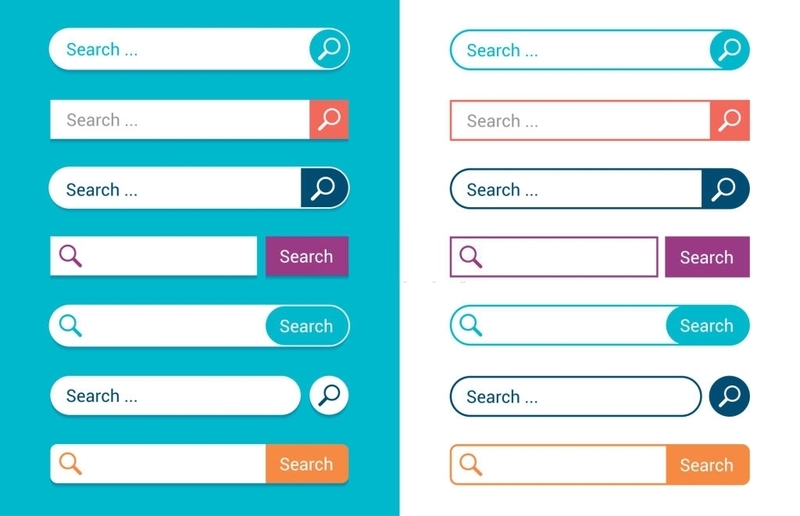
A user-friendly navigation bar makes a good first impression
App navigation is crucial for every mobile app design. It should be visible, intuitive and user-friendly. Navigation buttons should be colored contrasting with background and have enough visual weight. Every button must be interactive, clearly labeled and follow the same pattern across the app to ensure a smooth customer experience.
About the menu, categories should not overlap and are easy for users to understand the site’s structure. Putting the navigation bar at the familiar locations and using the tab bar for iOS and Navigation Drawer for Android is highly recommended.
Neatly design UI
Too many elements like texts, images, video, buttons on screen disperse the users’ focus and decrease the efficiency. Try to keep the app interface minimal and simple, highlight the unique or frequently-used features. Focusing on one or two actions per screen shows the best customer experience result. This helps app owners to deliver the concise messages to the customers.
Besides, white space and color should be used wisely. White space is used for separating different sections while the colors attract the focus. However, using too many colors will confuse and annoy the user.
Readability
Mobile screen is much smaller compared to desktop’s one. Hence, the design must be responsive to fit in the small screen. The content also should be brief, direct and visualized. Data and tables should be shown in various formats.
Also, fonts and colors of text need to be chosen carefully to keep the users’ focus and increase the interactions. The important information can be highlighted to catch the attention. Do not use more than 3 fonts in an app and the font size should be above 16px.
It is essential to keep tracking (space for groups of letters) and kerning (space between pairs of letters) consistent. The users might find it difficult to read if the tracking and kerning is too far or too close.
Buttons
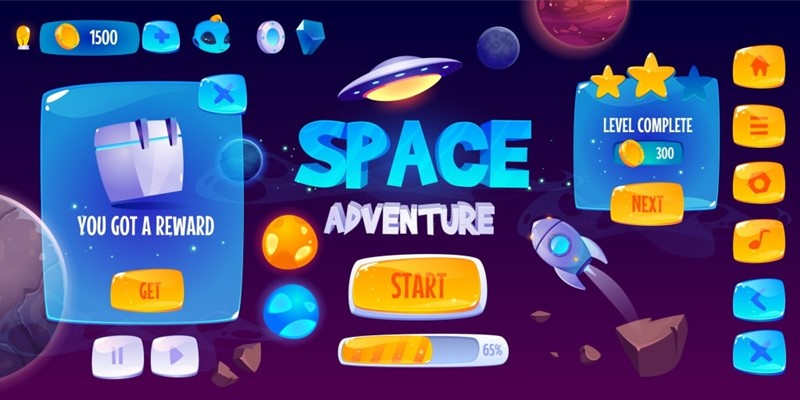
Simple buttons deliver clear messages
Simplifying button designs has been a trend. Do not make it too complicated as it takes time unnecessarily and returns the inequivalent result. A good button should be labeled clearly and placed in the discoverable locations. Here are a few button options that designer should consider for your apps:
- Square or rounded corner buttons (rounded corners have been more trendy recently)
- Ghost buttons
- Floating buttons
Finger-friendly tap targets
Friendly finger tap targets are top priority when designing apps for mobile devices. The finger tap targets must be visible, big enough for the user to tap precisely. They easily get annoyed when tapping the wrong targets multiple times. This might be caused by too small and condensed targets.
A UI designer should keep in mind that the average human finger pad is 10 x 14mm, the average fingertip is 8-10mm, making 10mm x 10mm a good minimum touch target size. The gap between targets also needs to be big enough so users do not tap the wrong ones
Don’t forget the thumb zone
Mobile phone size has become increasingly bigger, making holding it by one hand difficult. Hence, the designers need to pay more attention to the thumb zone where thumbs feel the most comfortable when interacting with the screen.
For example, try to avoid putting too many objects at the OW zone as it causes inconvenience for users when holding a phone with one hand. Instead, the frequently-used functions or buttons should be placed in the Natural zone.
Accessibility
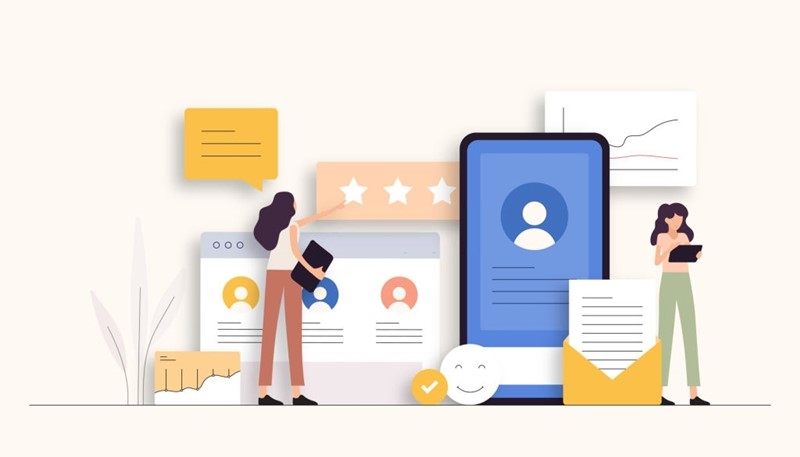
Apps should be designed to be accessible for everyone
A well-designed mobile app should be accessible, it means everyone can use the app without difficulty. Designers need to consider all kinds of users including the disabled, any type of impairments. For example, UI designs must be clear enough for color-blind users to have a smooth experience.
As mentioned, the color should be combined with high contrast as the high contrast backgrounds are easier on the eyes and can reduce eye strain and better for the users with low vision. Additionally, mobile apps should be provided in multi-language and the used language should be simple, clear and precise.
Contact us for a free consultation on Software Development and you will get all of the insights from our professional technical perspectives. Our Developers will advise you on the best approaches to the development process, as well as roughly estimate your project concept cost.
Reduce the number of user inputs
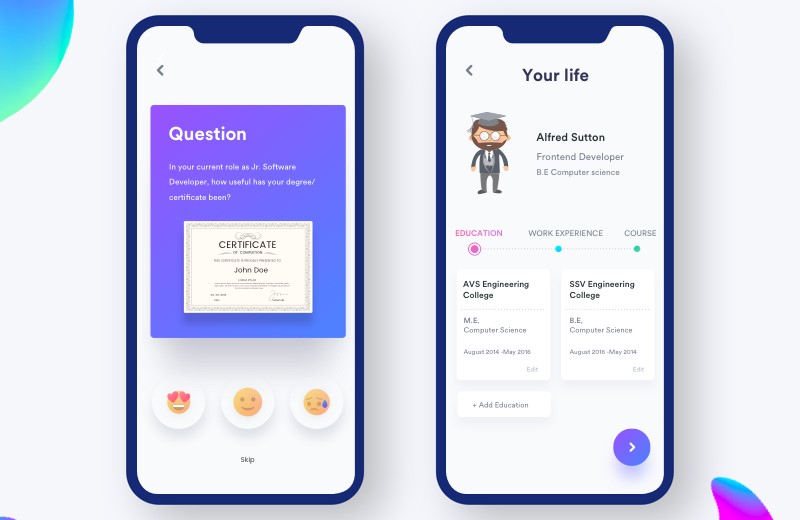
Mobile apps with few inputs are preferred
Businesses want users’ information, developers want to enhance security by 2-step verification, constant login, all these actions require users’ inputs. However, users need things to be done quickly and are reluctant to fill in information repeatedly.
The solutions for this might be a brief, direct and sweet form that can be done within less than a minute. Allowing users to save the info for the next inputs is also a great idea. The most important thing is ensuring the forms work well.
Make a great first impression
First impression is one of the factors keeping users continuing using your apps. If the users do not have a great first impression, your apps hardly have the second chance, nobody has time for a boring, unimpressive app. You can make a good impression by improving UI design and ensuring app running speed.
2. Top 10 Mobile App Design Ideas
In recent years, UI design is the most changing industry in the mobile app field. Here is a list of top ten mobile app design trends that will accelerate in 2021:
Tailor-made Personalization
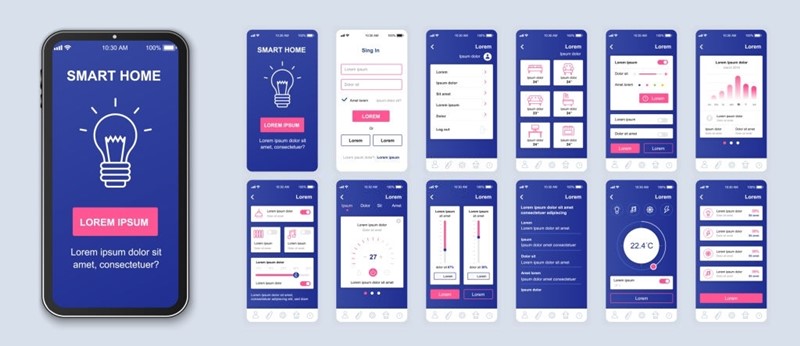
Tailor-made apps bring satisfying customer experience
There are over 3 million mobile apps existing on both the Google Play Store and Apple Store. Mobile app user expectation is all about end-to-end, customized user experience, especially in the context of COVID-19 when the demand for sharing screen and wallet becomes greater.
To win this hyper-competition and gain user engagement, conversion, mobile app designers need to equip their app with strong personalization backed up by strong UI/UX. It is the time when UI meets AI to uplift CX. This mobile app design trend matters even more in such industries as e-commerce, entertainment, and news. For example, streaming mobile apps including Soundcloud and Youtube offer song or video recommendations based on historical user choices.
Seamless Experience throughout Devices
According to Statista, by 2020, each user will have access to an average of 6.58 connected devices. Users expect a non-disrupting flow when moving from one device to another.
Therefore, device-agnostic mobile app design, which aims to create seamless UX throughout different devices, is an essential approach. App designers need to imagine the whole journey of the app user instead of thinking computer or mobile categories only.
Design with Rounded Corners
Rounded corner is another mobile app design trend accelerated from modern mobile devices Both iOS and Android physical devices, such as iPhone 12 or Samsung Galaxy S21 Ultra, have rounded corners. These curved corners gradually get reflected in the UI design of mobile apps.
This mobile app design trend is not only aesthetically pleasing, but also has a positive impact on the user experience. These curves make it easier for the human eye to see and more quickly for users to input data and carry out transactions.
Dark Themes
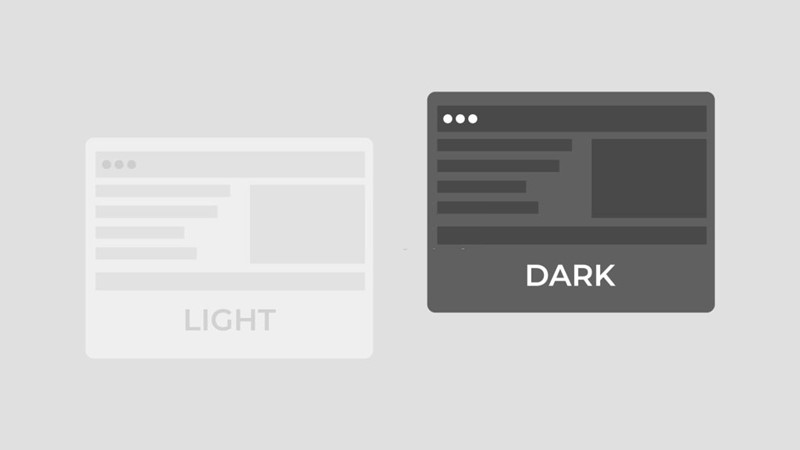
Dark theme has been a trend
A dark theme plays a role as a supplemental mode to the light theme, the default mode in other words. Dark themes change nearly the entire screen of UI to dark surfaces.
This mobile app design trend helps to decrease the luminance emitted from the displays, yet still ensure minimum contrast ratios. Like the former app design trend, dark themes have other functionality rather than merely aesthetics. When changing to dark themes, mobile app users can reduce eye strain, adapt screen brightness to the current lighting environment, and save battery power.
Voice-powered Interfaces
Voice User Interfaces are everywhere now. Apple’s Siri interface is an example of both voice and graphical user interfaces existing at once. Voice-powered mobile apps are facilitating our busy lifestyle in modern times to be easier, faster, and more convenient.
However, the way users interact with voice interfaces is very different from how they interact with graphical ones. More than just using technology, users expect the ability to communicate with and talk to a real person. Hence, to meet user expectations, mobile app designers need to determine the key factors which make their voice interaction stand out from the rest, or otherwise user experience will end up very frustrating if things go wrong.
AR/VR
Statista predicts that the worldwide user base for AR and VR will reach 443 million by 2025, meaning that it is becoming increasingly important for UX mobile app designers to create amazing VR and AR experiences.
Virtual reality and augmented reality technology enables app users to actualize what they see on digital displays in the real world. By providing app users with fresh and practical images in their daily routine, this mobile app design can create a holographic user experience that wow.
Password-less Login
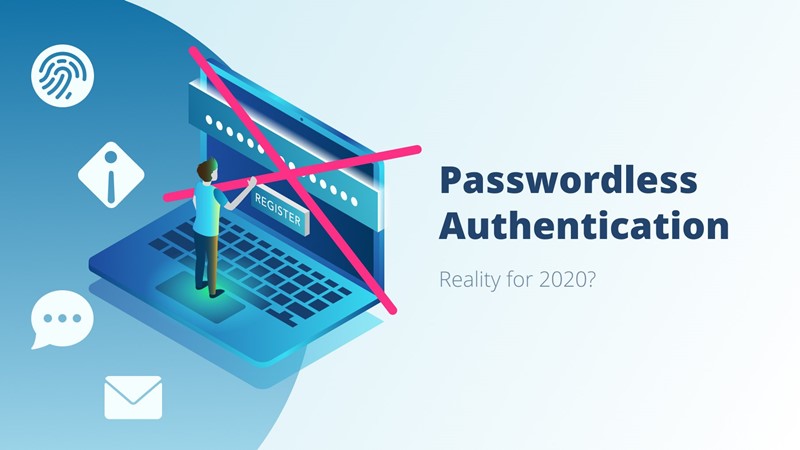
Password has been out of date in the modern era
According to Think With Google, users install and engage with an average of 35 apps on their smartphones. Failures to remember passwords of all mobile applications usually happen, disrupting user experience. Therefore, passwordless authentication is more preferred in mobile app design now.
Login by password is gradually replaced by facial or fingerprint recognition, also known as biometric recognition. Other less popular methods include sign-in links, pattern recognition, OTPs or one-time temporary passwords.
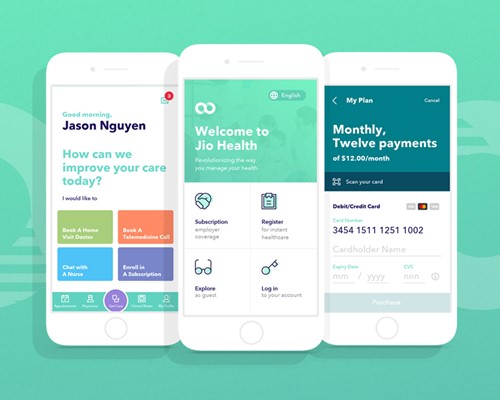
Jio Health – Telemedicine App Built by Savvycom
Our team can help you with the development of your application. Contact us to get a free initial consultation regarding your project and its estimation in terms of cost, timeline, and needed technical talent.
Liquid Swipe and Buttonless Design
This mobile app design idea is also inspired by modern mobile design. It’s been a long time since any of us use a mobile phone with a physical button.
With screen space freed, mobile app designers can provide users with more information, all the attention is focused on the content. At the same time, gestures are used instead of any physical or even digital buttons.
Chatbots UI/UX Design
Data from Business Insider shows that people are using messenger apps more than they are using social networks. If mobile app designers want to build a marketing machinery on smartphones, they need to create an environment which can optimize user interaction.
Hence, the role of Chatbot UI design is beyond information provision. It is more about processing personal query, in every type of language variations- different language semantics, emotions, slangs, phrases, and text structures.
To improve Chatbots UX, mobile app design needs to be customized by a set of options that can reflect their brand personality the best, including avatars, response buttons, and welcome messages.
Design for Disabled People

Disabled people should not be missed when design apps
More than 50% of all internet traffic in the world falls on mobile devices. The issue of access to information for people with limited physical abilities may have the same meaning as having absolutely no infrastructure for those people. It is impossible to become a complete member of society without the necessary access to information. There are many mobile app design ideas which will help designers optimize their accessibility in UX.
A display for the blind can help them to hear UI elements by reading out loud and offering vibration feedback and acoustic signals. Accessibility-first UX mobile app design can also adopt transcripts in audio or video content, combination of colors with high contrast, voice input, and gesture recognition technologies.
3. Great Mobile App Design Inspiration From Savvycom
From all the mobile app design tips and trends above, we suggest a few apps to keep you inspired!
Kokkiri – Meditation App
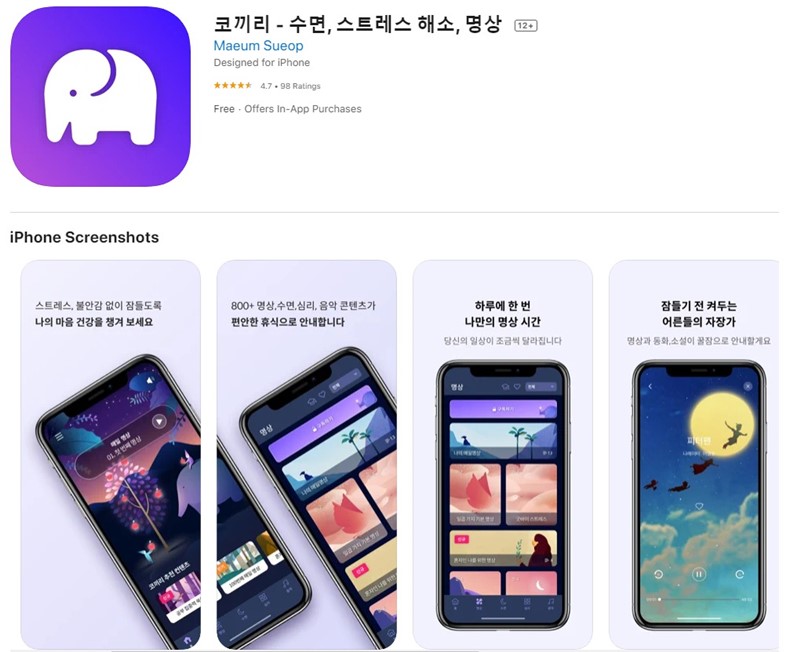
Kokkiri is a meditation and relaxation mobile application that provides relaxing sound recording and meditation/psychology classes for healing and relaxation of the mind. In the app, users will be able to explore the schedule, lessons, and track records and move up to a higher mental level.
The app has an attractive interface with beautiful illustrations and logical app navigation. Users could download the app easily through Google Play and the Apple Store. It is also integrated with various social platforms such as Facebook, Naver or Line to give users a sense of selection and convenience.
Jio Health – Telemedicine App in Vietnam
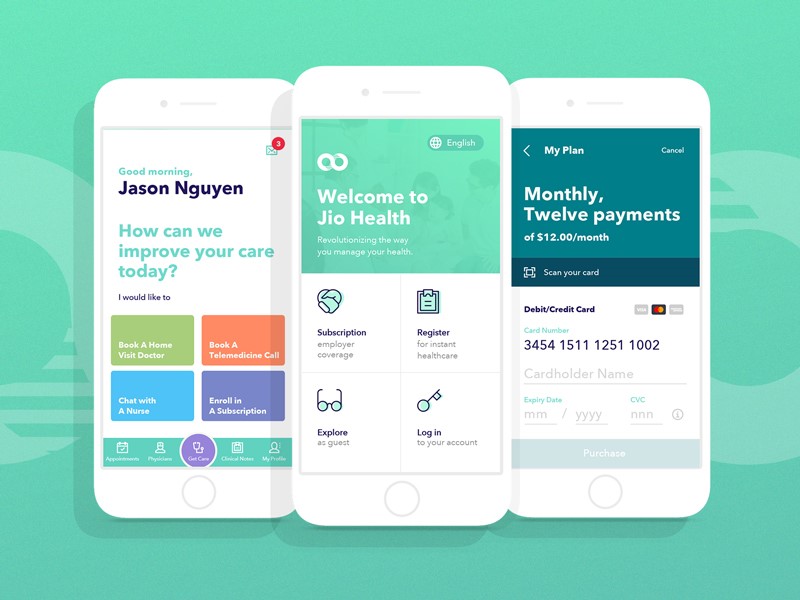
Among the uncertainties and challenges brought about by COVID-19, there are also a number of positive changes, such as the emergence of new technology that is helping people adopt a healthier lifestyle; from how they study and work to how they relax and consume entertainment.
Jio Health is your family’s private clinic. With Tech support from Savvycom, Jio Health deliver quality, trusted healthcare to your family online, in the office and at home.
Wanna Train – Fitness & Social App
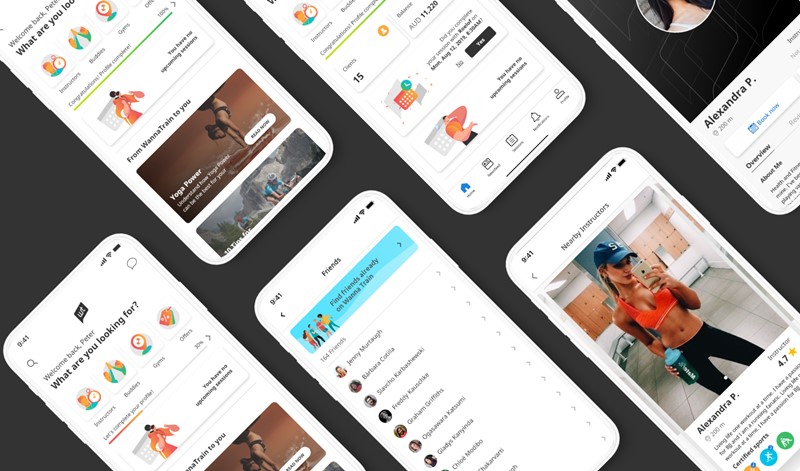
Connect with fellow gym members, friends and others nearby on Wanna Train Fitness Platform created by Savvycom. Whether you’re looking to snap and share a photo, network on similar training techniques, or simply stay in touch with other passionate fitness enthusiasts, WT creates a unique ecosystem that is changing the way people make healthy connections.
Interested in starting your own App Development?
Invent, build, integrate, scale and upgrade your Software Development with Savvycom! Since 2009, Savvycom has been harnessing digital technologies for the benefit of businesses, mid and large enterprises, and startups across the variety of industries. We can help you to build high-quality software solutions and products as well as deliver a wide range of related professional services.
Savvycom is right where you need. Contact us now for further consultation:
- Phone: +84 24 3202 9222
- Hotline: +1 408 663 8600 (US); +612 8006 1349 (AUS); +84 32 675 2886 (VN)
- Email: contact@savvycomsoftware.com
If there is an educational sector that stands to benefit from the resurgning interest in online tutoring, then that is the K-12 cohort. Last year, the tutoring market associated with this sector was worth $600 million. It is projected from 2019 – 2023, tutoring for this section would expand at a rate of 23% CAGR. So here we are, at your service, presenting a step by step guide to develop a tutor app.
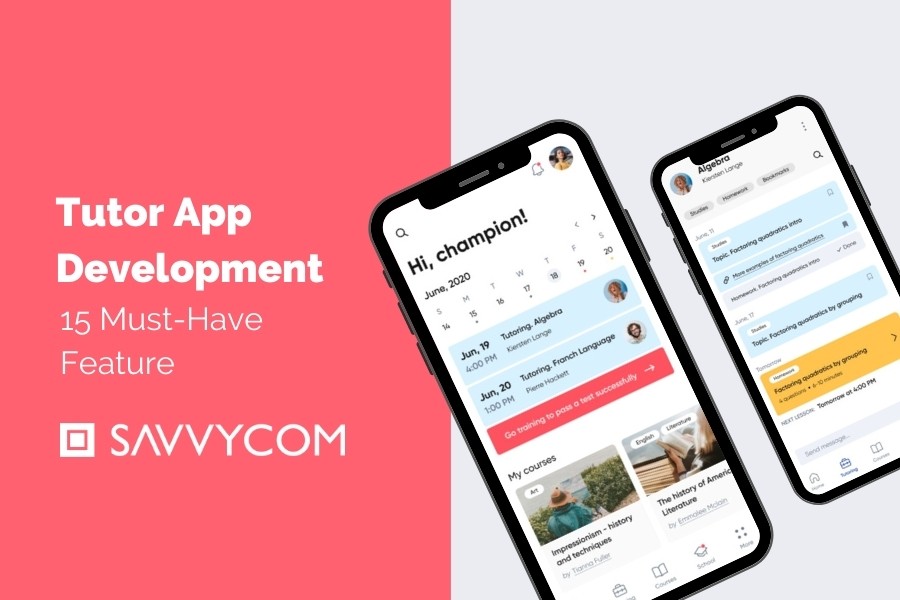
Tutor App Development Processes
Global mobile app revenues are expected to hit 581.9 billion in 2020. If you want even the thinnest slice of this pie the mobile application development must remain sleek from beginning to end. Whether it is a proprietary undertaking or involves a partnership with a tutor app development company, standard procedures must be followed. We’ll keep it short as our focus remains on the features of tutor apps, which makes up the follow-up section.
Step 1: Research as much as you can
Create buyer personas, draw app usage patterns, and demarcate your ultimate customer demographics from the crowd only to discover the reality that could be totally different. You need someplace to start and the safe haven of your thoughts, the birthplace of your brainchild, you must do hard research on.
Step 2: Wireframe your application

Wireframe is a visual guide that represents the skeletal framework
This step involves giving an artistic, user-end face to your applications. Define entry points, in-app navigation routes, exit doors, and all that the users will find in your app. Use storyboards to elaborate on user engagement. Get this step right and you shall have your work cut out for the next step.
Step 3: Check for technical sensibility
Ensure you have the right tool sets to help chart the journey. Having said that, what about the backend infrastructure to build and scale the app? When doing things in-house, reconnaissance the open-source, public API database and look for deployment-ready codes that would save you hands-on time.
Step 4: Prototype your app
Create a partial app at minimum development costs and timeframes. Release a version of it to limited users. What you’re essentially doing, is creating a Minimum Viable Product. This initial user response should let you predict future roadmaps or pivot, whichever is necessary.
Step 5: Designing the UI & UX
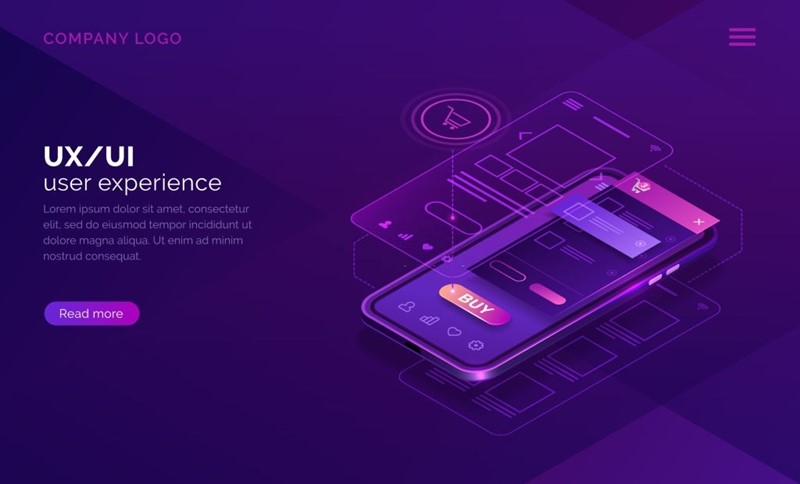
User experience design is the process of supporting user behavior through usability, usefulness, and desirability
Your app is beginning to take its shape and size. You have to perform a balancing act here managing the resources and trying to manufacture something that has a robust frontend and backend.
Step 6: Developing mobile apps requires you to adopt an SDLC model
These are methodologies which can optimize your development deadlines. The aim is always to minimize bugs, something that are as unrelenting and unpredictable as the mobile app trends themselves.
Step 7: Testing an app can never be over-emphasized
End of the day, your app is a code that was written by someone hoping that the operating logic and functionality used is right. You don’t want users to bad mouth your reputation on the app store because of an avoidable glitch. Testing the app will account for device compatibility, actual data usage, uptime, and everything that regards a digital product.
Step 8: Deploy the app on the App Store(s)
Once you’re sure of its product-market fit. The real job begins after this with you keeping a constant vigil on the state of operations. Put even more energy in your after-sales support and maintenance as you did in creating the product.
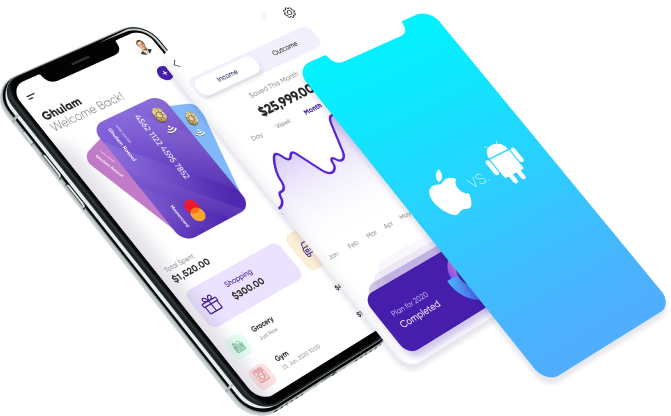
Are You Looking To Make Your Own Tutor App?
Our team is ready to consult you regarding the detailed development process and present preliminary project evaluation with an approximate app budget.
Must-have Features For An Outstanding Tutor App
The rise of apps in the online education industry has been nudged forward by parental insecurity for their children to miss out on timely education. Community schools are far from standardizing delivery for online tutoring services, due to which the private tutoring market is blossoming up. A standalone, private platform for tutors is faster to develop than an institution-centric application.
But saying this it does not take away from the feature sets of either category. Whether it is a school teacher at the other end or a privately hired tutor on demand, the following features in the app would better the overall experience for both the master and the apprentice.
1. Single Step Sign-in
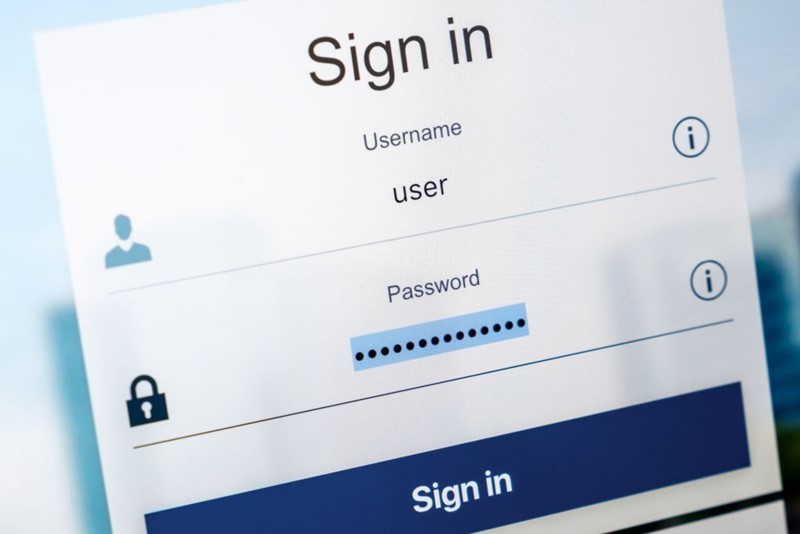
Sign in will be the first step when people go online
You want as many people to download and use the application as possible. But the days of long-format sign-up forms are a thing of the past. First-time users may not entirely want to stick around for the long haul. Make it easier for them to get into the app. Facebook or a Google sign-up option is the thing these days that instantly gratifies the user and moves them over to discover the app-content. If you want to keep it formal, then asking for an email, name, age and the mobile number should suffice. But no more than that. It’s better not to complicate matters by making users create brain-drain usernames.
2. Smart Search Option
Congratulations, Elvis has entered the building. The first thing a user would do is to search for relevant learning material. So how do you optimize this critical step? Implement a smart search that sniffs keywords out instantly. Run of the mill software developers miss out on basic functionalities that users expect. The scope of user search is limited. Hence, target all the short tail/long-tail keywords an average user might type in a frenzy, part of your algorithm. Then auto-suggest these as one types a query in the search field to make it easier for them to click and be directed to the relevant landing page.
3. Top Courses
Displaying the top courses on the homepage gives the student a broad idea of what the app is best suited to and the learning habits of people. Whatever you propose to educate students in, make sure you have a diversified, value adding course list. Udemy is one example. See how they boast their content repository and total users. The sheer size of the numbers would make anyone interested.
4. Personal Dashboard
Tutor mobile app development is all about reinventing the wheel. How can you make something as basic as a personal dashboard stand out? Introduce a recommended section based on the purchase history of users. Push your IT team to introduce a widget for 3 types of recommendations during the course of an education app development:
- Related courses as per user browsing history
- Related courses as per purchase history
- Courses purchased together
Alongside this, the dashboard should offer a progress meter sharing learning statistics for each individual.
5. Learn Where You Leave

With Online-Learning you should be able to learn from bascially everywhere
The Save Shopping Cart option where you save the stage of an order and return later to make the payment is a hit amongst the users. The same principle has been extended to education mobile app development. Immaterial of the circumstances, learners must have the option to pick their online, recorded lecture up right where they left-off. It sounds easy but requires high-level technological pedigree, the kind that Savvycom has proven time and again to have. Also, recorded sessions should be sequestered to auto-play once a video ends.
6. Offline Access
All the leading apps have this feature. No matter the nature of content, digital businesses are receptive to the fact that internet access is not the same at all places. To give an example, Netflix and Youtube allow you to download videos, with Hike you can chat in offline mode. Give users the access to download and carry their lessons as they see fit.
7. Interactive Assessments
Quizzes are a fun-way to conclude and test the retaining capacity of students. An online tuition platform would be no better than an e-book if there is no 2-way interaction with consumers. The tests, at the same time, shouldn’t be boring. This is where gamification comes into play. In fact, take it a step forward and introduce a test series for each chapter. For instance, students often return to a tutorial to repeat it. Provided your app has a revision tracker, students can be encouraged to take on new questions and see if they have actually improved.
8. Session Transcripts & Notes
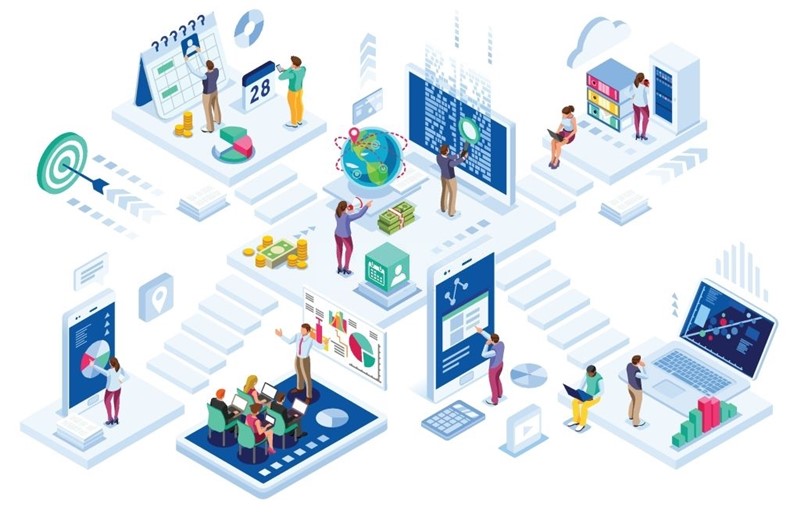
Materials are always present on your Tutor App & Learning Platform
Whether it is a live online class that you are a part of or an offline one, session transcripts are always handy. That should further be augmented with a Notes section that students can download. Educational app development should focus on minimizing student efforts and help them focus intently on the lesson at hand. In-app features should encourage direct interaction between trainers and the batches which brings us to our next point.
9. Instructor Log
The complexity of this feature is linked to the nature of tutoring services. For instance, if the app allows live instructor-student interaction, the instructor can have open discussion on a topic. They can post MCQ tests in the middle of the class to measure attentiveness and rate students who’d be automatically graded thanks to pre-feeded answers in the app. This rating can be synced with the personal dashboard of students and share pointers with guardians, just like a school report card.
10. Personalized Growth Plans
The point of reaching each student via smart devices is to identify and recommend a roadmap tuned to each student’s aptitude. Continuing from the last point, instructors can create a customized learning path having developed an understanding of each student’s strengths and weaknesses from the log. With the content bank ready to support the after-class needs of a student, they would know exactly what to study and what to derail for future in turn optimizing their time and learning.
Let’s discuss your app idea for online learning in greater detail. We will provide you with tech and business recommendations as well as estimate your project cost and timeline.
11. Q&A Pin-up Board
Not everyone is in the habit of jotting down doubts to confirm with online trainers. What if it’s a weekend? Would you want to be stuck up with your query for so long. Most of us would appreciate it if someone would attend us sooner than later. Therefore, tutoring services planning to launch operations should make room for an in-app section where students can post their doubts and instructors can reply within a stipulated time.
12. Notifications
With a physical space we know when to gear up and leave for classes. But what about e-tuition. That’s why timing reminders (pun intended) is critical. Send alerts to get students hitched to their screens or if they left a recorded session mid-way to come back and complete it. Notifications must be relevant to the user treating them as people and not mere customers.
13. Group Mode

Discipline is hard, isn’t it! But it becomes easier to do something hard when others are supportive of us. Similarly, studying in groups makes the experience worthwhile. If students can collaborate and learn a particular subject together, nothing like it. They could help each other understand the topic through live interaction or mutually pose questions to an instructor. Having a kaleidoscoping experience as an e-learning app development company we know exactly how to make this feature stand out with audio/visual effects and multi-format content sharing.
14. Multi Device Compatibility
You can never control which device the user would experiment with, or be forced to run your app on due to which it has to be accessible across all mainstream devices and operating systems. As an education app development company, another trend we see surfacing is Progressive Web Apps.
Mobile application development could be a little expensive as you continue adding features to the design. Due to which the concept of PWAs is picking up fast among budget-bound vendors.
15. Stream on TV
The sheer exclusivity of this feature would place your app in a league of its own. Imagine learning from a tutor on demand, with the entire session being broadcast on your television. It’s like watching a sitcom with your parents. Streaming takes the unwarranted seriousness out of the picture and makes you inadvertently enjoy it.
Will Tutor Apps Be Able To Maintain Their Growth Post-COVID?
You bet. Online education in general will last long modulating its structure in exciting ways, says the World Economic Forum. COVID-19 is not the cause here but an accelerator. Last year total global Edtech investments were valued at US $18.66 billion and they are expected to reach US $350 Billion by 2025. The 4 pillars giving foundational strength to this expansion are:
- Language Apps
- Virtual Tutoring
- Video Conferencing
- Online Learning Software
The highest valued Ed-tech company as of writing, BYJU’s is worth US $10 billion. This Indian startup monetizes the same virtual tutoring market we have been drum-rolling of in this article. That settles the argument once and for all.
Invent, build, integrate, scale and upgrade your Software Development with Savvycom! Since 2009, Savvycom has been harnessing digital technologies for the benefit of businesses, mid and large enterprises, and startups across the variety of industries. We can help you to build high-quality software solutions and products as well as deliver a wide range of related professional services.
Savvycom is right where you need. Contact us now for further consultation:
- Phone: +84 24 3202 9222
- Hotline: +1 408 663 8600 (US); +612 8006 1349 (AUS); +84 32 675 2886 (VN)
- Email: contact@savvycomsoftware.com
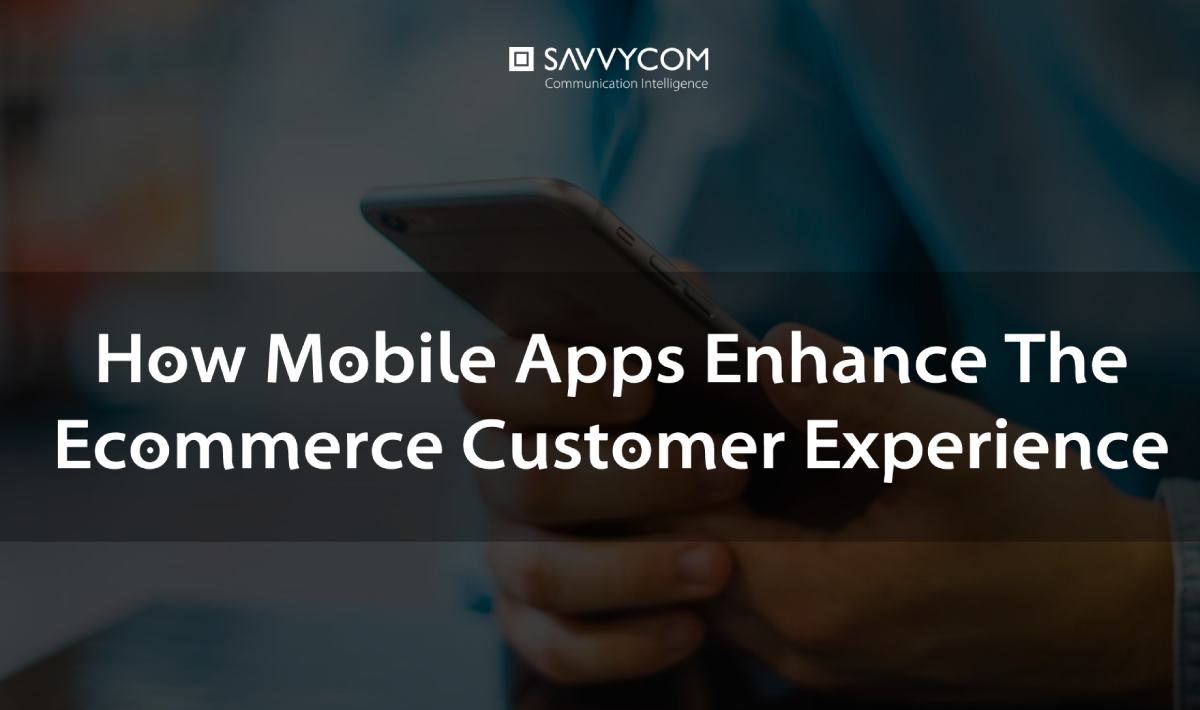
Mobile apps can dramatically enhance the experience of customers when they go shopping online.
Mobile apps are personal and tailored to users
Mobile apps collect a great deal of data from the user. Shopping behaviours preferred payment methods, and more can be harvested and held in the app.
This is obviously good news for your personalization strategy. Mobile apps provide big data that you can use to learn more about your customers and finesse your business and marketing strategy.
But this data also delivers value for the customer too.
The data collected can be used to create a bespoke experience that is tailored to the customer. No longer do customers have to navigate to a website and login to enjoy personalised shopping experience.
In a single tap, a shopper can immediately be shown the products they want to see, the offers they might enjoy, and pay in the method that they prefer.
A mobile app is a unique shopping hub that is focused on the individual. A customer’s personal preferences are there for them as soon as they use the app, enhancing their experience as a result.
Convenience is king
Convenience used to be a nice feature that set a brand apart from its competitors. Today, it is a necessity that is built into every business’s offering. Consumers don’t appreciate convenience — they expect it.
Mobile apps provide that convenience. They provide everything a customer might need, right there in the palm of their hand. Customer service can be dialled with a single tap and orders made in seconds.
A website might provide information to prospective vendors, shareholders, journalists, and so on. But mobile apps are geared towards specific users — the customer.
Consequently, apps only provide the functions and information that the consumer needs. It’s streamlined and optimized solely for the customer, giving them everything they need in a single app.
This is especially true for brands that focus on location-based services. Businesses like Deliveroo and Uber have enjoyed huge success from mobile apps, letting customers order food or ride right to where they stand.
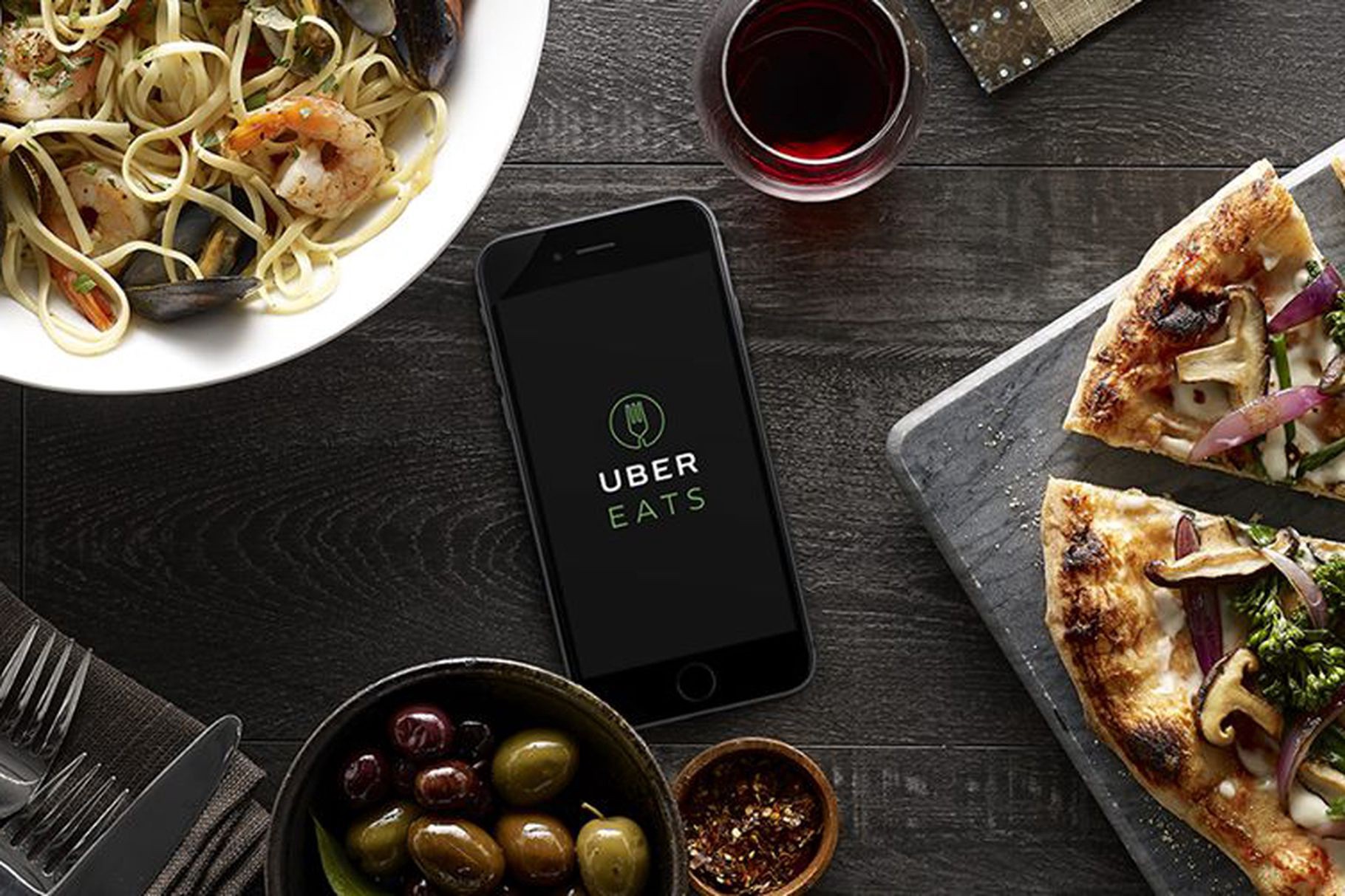
Uber Eats is a giant taking the big slice of the earnings | Source: Eater.
Consumers demand multi-channel e-commerce
Beyond convenience, consumers also expect a multichannel presence from brands. While the traditional online store still has its place, shoppers also expect to be able to interact with and buy from brands in a variety of places online.
Multichannel spreads itself across many channels: social media, messaging apps, online marketplaces, and so on. And mobile apps are a key part of this multichannel experience.
While a mobile app might be out of reach for solo businesses, most enterprise e-commerce platforms provide solutions for a multi-channel experience out-of-the-box.
Savvycom, for example, partners with a number of SMEs which want to develop apps to help their users incorporate mobile into their multi-channel strategy. Solutions like CRAVE Vend offer user-friendly app development that seamlessly integrates into their e-commerce presence.
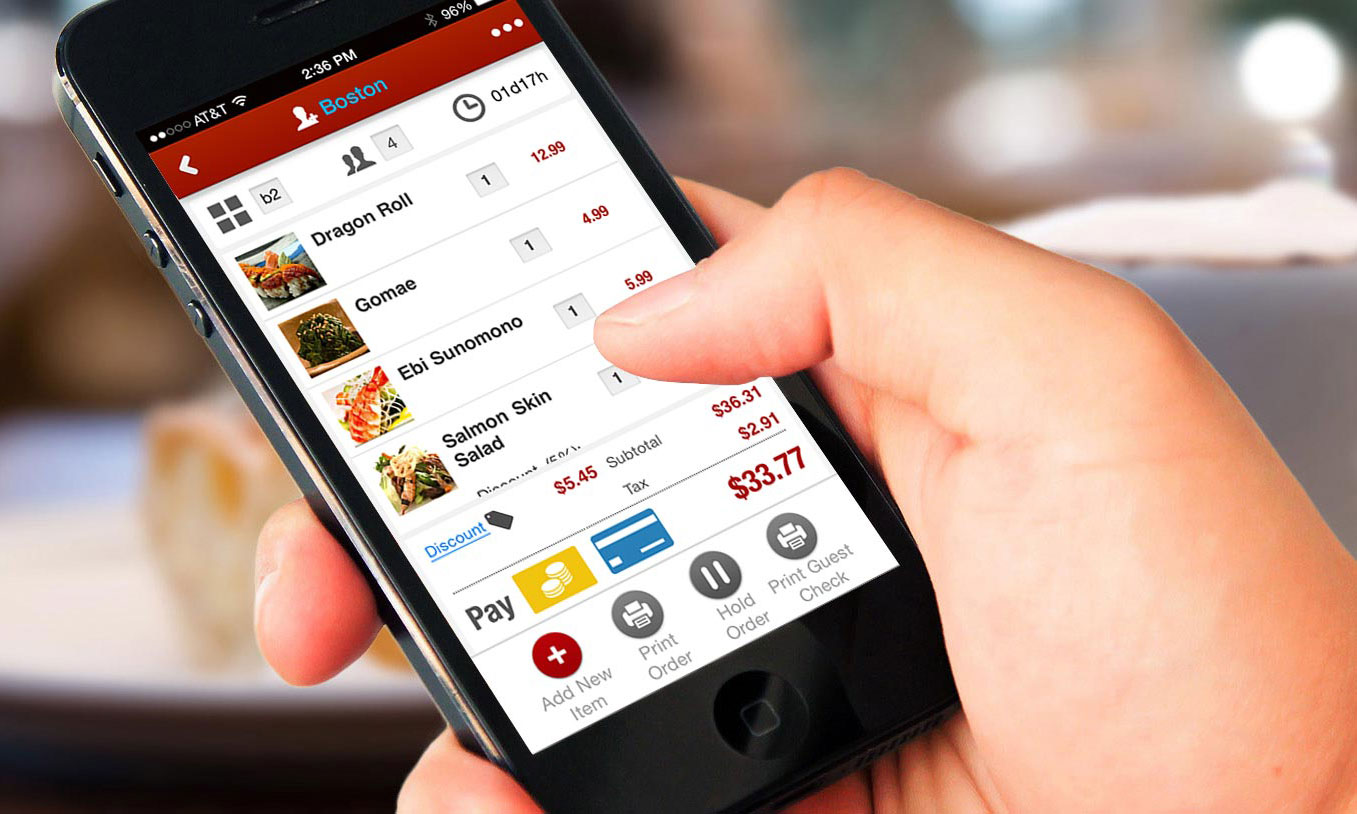
CRAVE Vend is a smart POS solution for operational efficiency improvement.
As this piece explains, “the multi-channel approach gives users access to everything they want, with consistent user experience. Same app, any device.” Consumer expectations are high, and mobile apps create a seamless multi-channel experience that customers love.
Apps exceed online stores in expectations
We live in a mobile-first age. Consequently, every e-commerce business should strive to create an optimized mobile experience for their customers.
But even the most seamless online store comes second to the mobile app experience. A significant 85% of consumers prefer using a mobile app over a mobile site when shopping online, and with good reason.
For starters, apps do not lose functionality when used over a tenuous internet connection. While web browsers might redirect to a 503 error page, apps continue to work as they should. Performance is fast across multiple devices and doesn’t lag, delivering an optimized experience regardless of how where customers access the app.
Apps are interactive and engaging
Mobile apps differ from your web-based online store in that they are interactive.
Interactivity is how your customers engage with your brand. It creates a two-way relationship that your rewards the user, keeping them locked into the buyer’s journey.
Apps create more opportunities to interact with your customer. Beyond simply ordering and purchasing products, customers can browse brand content that is useful, informative, or simply entertaining.
This can even be the sole purpose of your mobile app. The luxury fashion brand Chanel’s mobile app doesn’t have any ordering function.
Instead, it lets fans try on sunglasses in augmented reality, browse behind-the-scenes content, receive updates about forthcoming shows, and find their nearest Chanel outlet. Strictly speaking, Chanel’s app is not e-commerce-focused. But it enhances the customer experience by encouraging interaction with the brand.
Mobile apps also complement the offline customer experience too. 72% of smartphone users use their devices to inform in-store purchases. Consequently, your mobile app can provide further information such as comparison guides, user reviews, and even discount codes for offline customers.
Create an interactive app that your customers can engage with beyond ordering and buying products. Provide relevant content that is useful or entertaining and cater to your customers’ needs beyond simply purchasing a product.

How mobile apps win customer experience (Source: Simicart)
Mobile apps enhance e-commerce customer experience in a variety of ways. From delivering convenience to providing a multi-channel experience, mobile apps create a memorable experience that ensures your customers will return to your brand time and again.
Connect us for various frontier technology services and IT excellence:
- Phone: +84 24 3202 9222
- Hotline: +84326752886
- Email: contact@savvycomsoftware.com
- Hungry for more? Find out here!
If your heart pounds when thinking about the way Instagram working wonders and wish to make an app for yourself, then it’s important to deep-dive in the cost structure of building an Instagram-like app in this part 2 of the series.
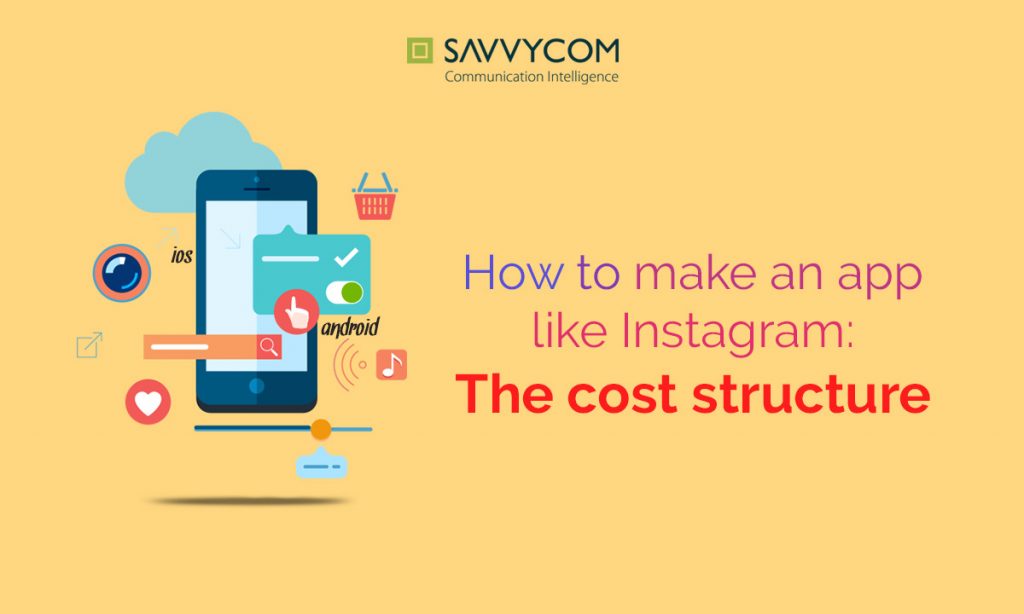
It’s crucial to deep-dive in the cost structure of developing an Instagram-like app from scratch.
Making your Instagram alternative from scratch
Once mentioned in part 1, although Instagram has certain distinctive selling points, it’s still built based on some basic functionalities that every photo-sharing app must have.
The cost of developing such functionalities will vary depending on the choice of different platforms: iOS or Android, native or hybrid.
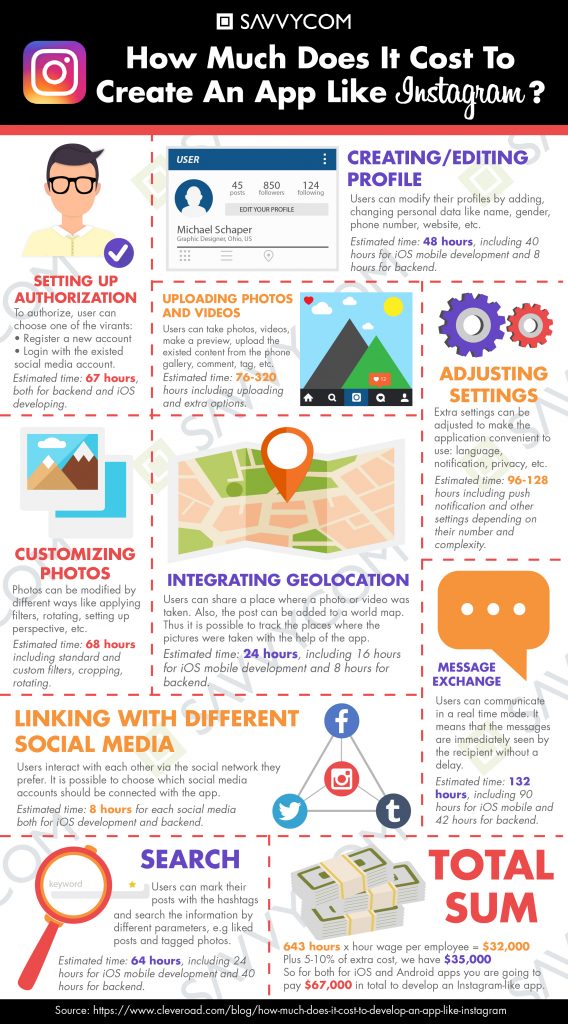
The cost structure of building an Instagram-like app in a nutshell | Source: Cleveroad.
Wonder to know how much does it cost to make an App? Our 2019 industry research about app pricing will help you! Don’t miss it!
Setting up authorisation
People will never know what’s so awesome about your app if you don’t build an open door. Therefore, fast, easy, convenient authorisation shall be the first thing you think of as it’s the starting point of the customer journey.
As of Instagram, to have the account authorised and access to the main functions, it offers users with a couple of choices.
They can either create a brand new account on Instagram itself by clicking “Sign up” at the bottom of the screen and register right away or simply sync their current existed social network accounts (Facebook account in specific) to get logged in.

Instagram offers users with a couple of choices to have an account authorised | Source: BusinessDigit.
Besides, imagine how terrible it would be if people have to create a brand new account every time they forget their password or get it hacked/stolen.
That’s why there is always an option called “Forgot password” where users can set up a new password in case of emergency through email, phone number or social media account. Life is much easier now!
In addition, remember to save the users’ data on the backend. For this action, you will need a strong database same as the OAuth open authorisation protocol for logging-in security. Don’t let DDoS attack threaten your app lifeline because of one silly mistake in authorisation developing.
All things considered, the estimated time for both backend and development is about 67 hours.
Creating and editing profile
To personalise and validate one’s account, a must is to build a profile. This feature will allow users to add and modify their basic information (name, phone number, email, gender, etc) and bio so that you could easily follow your users’ footprints and make their experiences more distinctive and fulfilled.
Talking about the backend, in this part you have to establish an interaction between the client and the server-side of the application.
This function will take about 48 hours away from you, with 40 hours for mobile development and 8 hours for the backend.
Adjusting settings
This is the area where you offer various extra settings to users for personal suitability. It shall include some simple categories, such as notifications where you manage all notices from other accounts, privacy and security for account protection, payments methodology, and other account settings (language, photo quality, etc).
If you want to allow the push notifications, it becomes important for the server to get connected with the Apple or Google server. You need to register on the Google or Apple server and provide an appropriate ID. The server will send the notifications through the ID afterwards.
The estimated time falls between 96 – 128 hours, including push notifications depending on their numbers and complexity.
Uploading photo and video
The vedette of the show! This feature is the foundation of the whole photo-sharing thing, so you shall make sure it’s close to flawlessness.
Here users can take photos, record a video, make a preview, upload existed photos in mobile phone with multiple of image size. In addition, some interaction functionalities should also be included such as tagging, commenting and liking.
In case you want to personalise your own app with different unique points to Instagram, you can breathe a new wind this feature, such as switching to live streaming feature as discussed in the previous part.
For instance, regarding Helo, a live streaming app created by Savvycom, the main function is no longer uploading photo and video as Instagram, but recording your appearance and activities in real-time so that your friends could interact with you just straight away.
They might be similar in some basic functionalities, but different from the core idea. By guaranteeing your unique, innovative points, you could differentiate your product from Instagram, taking it to a whole new level and earn even more money than Instagram does.

According to Mindinventory, as far as the backend is concerned, you have to opt for different approaches to Android and iOS platforms.
In the case of Google, the initial activity is reading the Camera API, MediaRecorder classes, android.hardware.camera2 API, and SurfaceView.
On the other hand, if you are developing an app for Apple devices then you have to use UImagePickerController, which is a part of the UIKit Framework.
This effort will cost you about 76 – 320 hours.
Customising photos
The trick here is to exert a little more effort in the functions having “photo” in their name because now you’re meant to develop a photo-sharing app like Instagram.
Photo customisation will centralise your idea of a photo-based app as well as improve user experiences by letting them play with photos and allowing them to showcase their aesthetic, creative side. Some actions users can apply here are filter adding, photo cropping/rotating, perspective setting, etc.
About the backend, there are two available options: one is that you can make use of any standard file, and the other is to create your own files.
With the first option, you just have to copy the ready source code to your project – effortlessly, whereas the latter option requires you to write the entire source code on your own. Which one to choose is totally up to your app’s characteristics and your own preference!
To materialise these seemingly complicated features, 68 hours of work should be taken into account.
Integrating geolocation
Not limited to photo-sharing platforms like Instagram, geolocation is in fact out of sheer similar to any social network. This application allows users to pin and share the place where a photo or video was taken.
The post then is saved into the location’s gallery as well as the world map, which serves the intention of place and photo tracking. This is very convenient in case users wish to research a travel destination before actually going on a trip.
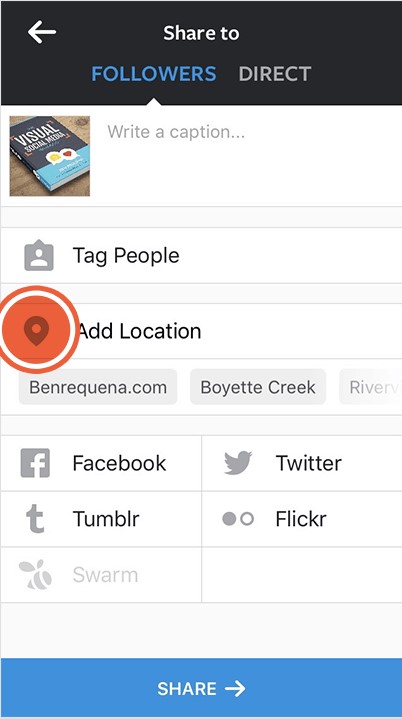
Source: the Internet
In order to embed this feature into your app, you would need the support of APIs. Once again, different approaches are posed between Android and iOS platforms, depending on the Maps and Locations.
If you are planning to build the app on an Android platform, you need to use the class of Android.location package and maps service by employing the MapView class. However, if you’re going for the iOS one, you will need a hand from CLLocationManager Class and maps service using the Map Kit framework.
After the front-end receives the data from a sensor, they send it to the backend. However, you need to acquire the permission of the users before sending the data. The data gets saved in the server-side and the image is returned to the user indicating the location.
Hereby, the estimated time is 28 hours, with 16 hours for mobile app development and 8 hours for the backend.
Search
Apart from the simple search methodology, one of the unique points of Instagram #hashtags, which allows users to look in the posts using some specific words attached to the hashtag.
For example, before posting a photo on Instagram feed, users could include some hashtags such as #instagram #selfie #ootd to mark their photos and use those hashtags as keywords to trace them back.
On the other hand, users can also search for their liked posts, tagged posts or trending posts, depending on which type of photo they’re looking for. Users will choose their preferred option and the backend server offers the desired results.
The estimated time for this is 64 hours, including 24 hours for mobile app development, 40 hours for the backend.
Message exchange
“Expression and communication are essential, without them, civilisation ends”
– Haruki Murakami
Men’s desire to talk and to be heard is as old as time. More or less, we all want to converse and communicate – it’s part of the river of life.
The need for communication rises so high that we create a virtual tool to improve communication level. Therefore, the messaging function should also be included in almost any app to enhance user satisfaction and engagement.
It allows users to communicate in a real-time mode, meaning that the messages are immediately sent to the recipient without any delay. As a result, this poses an additional problem for developers, which is the notification button to keep users informed about the incoming message.
It is also very essential to protect the server from excess loading of the incoming and outgoing messages. In order to achieve your ends, you can make use of RESTful API on HTTP as a replacement of permanent socket connections.
Similarly, if you want to have the notifications implemented, you had better get your app linked with the Android or iOS server through device authorisation on the server. You can use APN or GCM for doing it as well.
This is the most time-consuming functionality, with 132 hours of work in the estimation, including 90 hours for mobile development and 42 hours for the backend.
Linking with different social media
Having some friends by your side is often advantageous. Today, users not only use one single social network but various ones, so have them linked altogether is a wise move.
With this function, users can share their photos, videos, information and much more through different platforms, therefore, increase your app’s accessibility and convenience. Users can choose which social accounts should be connected with the apps as well.
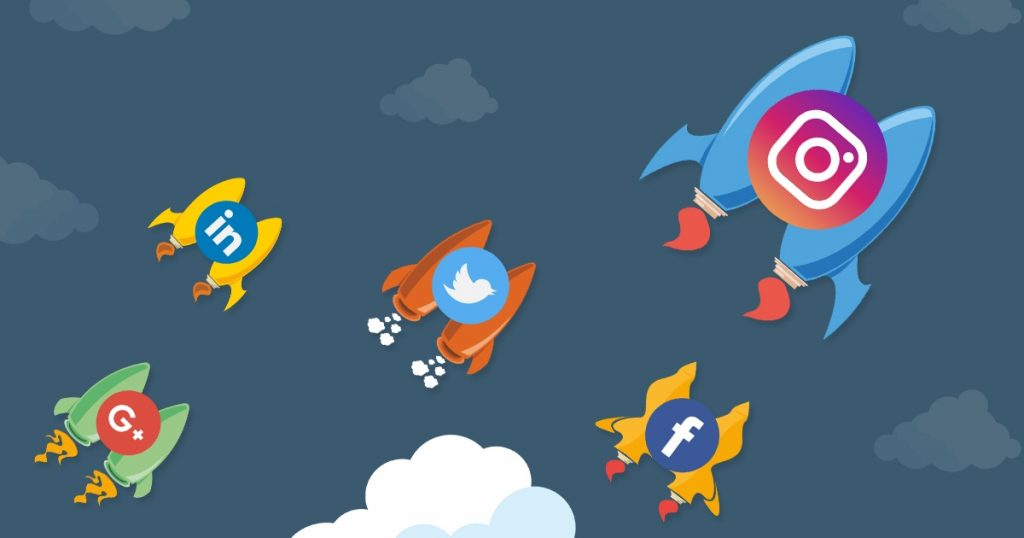
Source: Social Pilot.
The estimated time is 8 hours.
Total Sum
All basic features considered, the total amount of estimated hours an Instagram-like app takes out of you is about 643 hours.
If you multiply it by hour wage per employee, the number will escalate to approximately $ 32000.
After using 10% of the extra cost, which is about $35,000, the final number is $67,000.
Conclusion
We are living in an era where social networks are the king. Having a social media platform such as Instagram would offer an all-around advantage to instigating your business prospects.
However, before making up your mind, it’s still crucial to take into consideration the cost and the effort of making it so that you can visualise the essential steps and prepare the budget beforehand.
Connect us for various frontier technology services and IT excellence:
- Phone: +84 24 3202 9222
- Hotline: +84326752886
- Email: contact@savvycomsoftware.com
- Hungry for more? Find out here!

